Volume 13 Number 1
©The Author(s) 2011
Introducing the Project Approach and Use of Visual Representation to Early Childhood Education in Bhutan
Abstract
This article describes a collaborative action research project that followed two teachers and their students in a primary school in the Paro valley of Bhutan as they began to implement the Project Approach and promote children’s use of visual representation. The article begins with a description of the primary education system and teacher preparation in Bhutan and goes on to discuss a professional development workshop that led to the action research project. The article then describes two projects undertaken by classes of 6- to 7-year-olds at Taju Primary School, including photographic documentation. The article concludes with a discussion of the benefits of project work for all involved.
Background to the Study
Author Background
In April and May of 2010, the authors undertook a research project to document the introduction of the Project Approach and uses of visual representation to a small primary school in Paro, Bhutan. First author Margaret Brooks is a senior lecturer in the School of Education at University of New England, Australia. Second author Tshering Wangmo is the program leader for Primary Education at Paro College of Education, Bhutan.
Kingdom of Bhutan
Located at the eastern end of the Himalayas, and bordered by India to the south and China to the north, Bhutan is a small democratic kingdom of about one million people (Figure 1).
Figure 1. Map of the Kingdom of Bhutan
(Source: Wikipedia).
Bhutan remained in self-imposed isolation from the world until the 1960s. While this isolation preserved Bhutan’s unique culture and environment, it had a negative impact on education and health in the country. Subsequently, much of the focus for development has been in these areas. In Bhutan, development policies and practices must address the plan called Gross National Happiness. Gross National Happiness, initiated by the fourth king Jigme Singye Wangchuk, is the country’s foundational development philosophy, and it is seen as an alternative to emphasis on Gross National Product (GNP). Currently, efforts are underway to infuse the Bhutanese education system with Gross National Happiness (GNH) values. The four foundational pillars of Gross National Happiness are (1) sustainable and equitable socioeconomic development, (2) environmental conservation, (3) preservation and promotion of culture, and (4) good governance. These four pillars are presumed to require an educated population. Bhutan's Tenth Five Year Plan (Gross National Happiness Commission, Royal Government of Bhutan, 2009) has particularly identified early childhood education as one of the new areas for development.
A Brief History of Primary Education in Bhutan
Until the early 1960s, formal youth education took place in the Buddhist monasteries and was for the sole purpose of teaching Buddhist scripture to young monks and nuns. Rote learning, generally without the requirement of understanding until at least adolescence, was the prevailing method of instruction. Such a centuries-old approach to education found a comfortable home in the Bhutan’s first schools in 1962.
This approach still prevails in Bhutanese primary schools and is seen as an important part of students’ preparation for their semiannual examinations. Beginning with their first year of school, all students take exams at mid-term and at the end of the year. These exams are summative with a very small continuous assessment component. A child’s progression through the grades is contingent on passing these exams. Grade 6 students take a national exam. Grade 10 students have an exam for the Bhutan Certificate of Secondary Education. The grade 12 exam for the Bhutan Higher Secondary Education Certificate determines whether a student can attend college and which subjects he or she will study.
Rote learning in preparation for the tests emphasizes factual recall rather than development of higher cognitive functioning such as reflection, critical analysis, evaluation, and synthesis of ideas—abilities that are seen as essential for the rapid modernization to which Bhutan aspires. Subjects such as the arts and physical education historically received little attention and are only now being introduced into the schools.
School is free for children in Bhutan and is well attended. Most of the children come from homes where the parents are illiterate. There are approximately 40 local dialects in Bhutan. The first language of most children beginning school in Bhutan is their local dialect; their second language is Dzongkha, the national language; and the language of instruction is English. (Monastic education is different—the language of instruction is Dzongkha, with a trend toward teaching English as a second language.)
Teacher Preparation in Bhutan
Initially, Bhutanese teachers received no training and had little formal education themselves. Formal teacher training began in Samtse, Bhutan, in 1968, with short 10-week courses. The next two decades saw considerable improvement in teacher training, beginning with training to teach at the secondary level. The first secondary teachers graduated in 1986 with a 3-year bachelor’s degree. In 1993, the secondary program was modified for primary teacher training. Bhutan’s approach of watering down and adapting curriculum designed for secondary education for use with primary students is now recognized by Bhutanese educators to be inadequate and particularly unsuitable for the younger children. This particularly applies to pedagogical methodology, because young children do not learn in the same ways as do older students. Concern about the quality of learning, and by implication, teaching and teacher training, in the lower primary classes is widespread in the country.
Bhutan is experiencing fundamental changes in several areas, including the shift from monarchy to democracy, the development of Gross National Happiness, and the modernization of its education system from the monastic system to a more “liberal” education that also accommodates the specific Bhutanese context. These rapid changes make cognitive, emotional, and behavioral demands on Bhutan’s teachers to which they may not yet be able to fully respond; such changes require them to teach in ways that are very different from the ways they were taught. Unless their teacher training profoundly changes their beliefs about what constitutes good teaching, they will almost inevitably fall back on practicing the pedagogy with which they are most familiar—the “chalk-and-talk” transmission model of instruction.
Workshop for Teachers
In response to a growing concern that teaching methods for children in lower primary schools in Bhutan were not “child friendly,” the Ministry of Education in Bhutan and the Royal University of Bhutan engaged the first author to assist with the development of teaching methods that might be more appropriate for young children. The first author’s subsequent work with Bhutanese teachers was guided by closely related theoretical and practical perspectives.
Recent sociocultural research has led to awareness of the need for instructional innovations that are responsive to particular contexts as well as to the varying learning needs and the interests of individual children (Fleer, Edwards, Hammer, Kennedy, Ridgeway, Robbins, & Surman, 2006). It is widely recognized that teaching and learning for young children should be integrated, multimodal, and focused on in-depth understanding, with the aim of engaging children intellectually and developing their higher-level thinking skills (Brooks, 2009a).
Curriculum integration promotes continuity across subject areas. When curriculum also involves strong links between home, community, and school, a wide range of opportunities can be found to engage in activities that are meaningful to the children and that build on their strengths (Gonzales, Moll, & Amanti, 2005).
Educators should have concern for deep and memorable learning as well as memorized learning (Egan, 2010). Young children need opportunities to work cooperatively on complex open-ended tasks as well as to follow instructions in step-by-step learning. The Project Approach (Katz & Chard, 2000), widely used in early childhood and primary schools in many countries, is foundational to creating learning and teaching experiences that are holistic, meaningful, and engaging. Use of the Project Approach is compatible with the development of child-centered learning and child-friendly schools. For these reasons, the Project Approach was selected as a topic for professional development with the Bhutanese teachers, as one method that might be especially appropriate for young children in Bhutan. Use of visual representation by children was also chosen as a focus area for teacher professional development because of its ability to provide a strong tool for learning for young children (Brooks, 2009a, 2009b).
The professional development work and the subsequent action research project began with an intensive, interactive 5-day workshop. Attending the workshop were about 10 primary education lecturers in creative arts and teaching methods and two classroom teachers from a local school.
The workshop took a transformative and sociocultural approach to exploring “local funds of knowledge” (Moll, Amanti, Neff, & Gonzalez, 1992; Gonzalez et al., 2005), the Project Approach (Katz & Chard, 2000), and the use of visual representations (Brooks, 2009a, 2009b). That is, the participating lecturers and teachers engaged in collaborative learning activities that were designed to assist in the transformation of existing beliefs and practices (Edwards, 2010), such that their learning would lead development (Davydov, Slobodchikov, & Tsukerman, 2003). A transformative approach, in this context, is one in which teaching and learning are in dynamic and reciprocal relationship; it is founded on the principle that theory and practice are joined to form praxis (Wink & Putney, 2002).
Workshop participants began by identifying the many “local funds of knowledge” (Moll et al., 1992, Gonzalez et al., 2005) in their communities in the Paro valley. Moll and colleagues (1992) define funds of knowledge as “historically accumulated and culturally developed bodies of knowledge and skills essential for household or individual functioning and well-being” (p. 133). We then discussed the potential for engaging such funds of knowledge in the context of the classroom and curriculum. Crops, gardens, and growing things; shopkeepers; the market; an automotive repair shop; cooking; weaving; festivals (masked dances); and monasteries were among the funds of knowledge that were identified as being available to support classroom investigations into possible topics that might link home and school.
Next, in the context of observational drawing, participants were introduced to new, responsive art materials (e.g., charcoal, chalk pastel, oil pastels, watercolor paints, and color pencils), none of which they had experienced before.
Finally, three small working groups of workshop participants selected topics for their projects that would also be meaningful for local children and would provide for rich firsthand experiences. Then, under the first author’s guidance, the three groups worked collaboratively to undertake in-depth studies of their topics, integrating the use of both local funds of knowledge and the new materials for visual representation. As they engaged with the three phases of their projects (Katz & Chard, 2000), they reflected upon and discussed their experiences.
Action Research Project
The collaborative action research project here described followed two teachers and their students in a primary school in the Paro valley of Bhutan, as they began to implement the Project Approach and promote children’s use of visual representations. Our research was built upon the teachers’ workshop experiences, with the purpose of examining how they further engaged with the ideas from the workshop when they returned to their classrooms. The aims of this project were twofold. First, we sought to discover and document how these early childhood teachers used their knowledge of the children, families, and the community to create culturally sensitive and meaningful learning experiences for young children through the use of the Project Approach. Second, we wanted to document ways in which the teachers helped children use visual representation to support their learning in the context of project work.
Interpretive Enquiry and Action Research
Interpretive enquiry and action research were chosen as research methods for several reasons. Action research can be viewed as a process of professional development (Grundy, 1995); the participating teachers and the researchers had regular focus meetings throughout this study, which was concerned in part with their professional development. Participatory action research also gives local participants a “voice” (Carr & Kemmis, 1986, cited in Cohen, Manion, & Morrison, 2007, p. 29). Both interpretive enquiry and action research entail cycles of understanding, planning, implementation, documentation, and critical reflection that have been shown to enable participants to identify key issues and uncover deep understandings. These characteristics made them especially appropriate to the study of teachers’ uses of the Project Approach and visual representation with young children.
Data Collection and Processing: Visual Ethnography
The practice of ethnography has increasingly integrated visual images (Goldman-Segall, 1998; Pink, 2002). Video and photographs have the ability to represent gestures, expressions, a sense of emotion, dialogue, and contexts in ways that written notes do not. During this study, visual ethnographic methods, particularly photography, offered us strong support for inclusive and collaborative research, allowing collection of a wide range of experiential data and acknowledgment of the multisensory, pretextual, and cultural experiences of the participants (Brooks, 2006). Visual ethnography is an inclusive methodology that does not rely only on textual fluency and experience with ethnography. Participants were able to share the task of collecting and interpreting data, which helped to create a more equitable and informative research environment. Cameras were given to each of the teachers, lecturers, and researchers for documentation purposes during the study; the first author’s husband also contributed to the photodocumentation.
Data analysis and meaning making were ongoing interpretive processes throughout this investigation. It is possible for an image to have more than one meaning. For that reason, during this study, engagement of all participants was facilitated through discussions about the meanings they brought to the images and the sense they made of them. These discussions were important sources for informing researchers of a range of perspectives (Pink, 2002); interpretation of an image was based on the content of the image as well as the perspectives of the participants.
Data collection activities were propelled by ongoing analysis, which in turn informed subsequent inquiry. The qualitative data were systematically examined through a sociocultural lens for common themes. Foci for analysis linked back to the research questions.
Taju Primary School: The Research Context
Taju Primary School, located on the outskirts of Paro, serves 505 children between 5 and 12 years old. It opened in 2005 and therefore has fairly new buildings with 14 classrooms (Figure 2). However, the school lacks teaching materials and library resources. Most of the classrooms have 35 or more children. School uniforms are compulsory.
Like all schools in Bhutan, Taju Primary holds classes in two terms—February to June for the first term and July to December for the second term. The school operates for 6 days a week, and classes are held from 9:00 am–4:00 pm. All of the school’s 23 teachers have university training. 
Figure 2. Taju Primary School, Paro, Bhutan.
Classes in lower primary (i.e., Pre-Primary, Primary 1, Primary 2, and Primary 3) serve children from age 5 to about age 8. Primary 1 children are 6 years old; Primary 2 children are age 7. A lower primary class usually has the same teacher for all subjects. The subjects taught include English (also the language of instruction), Dzongkha (the national language of Bhutan), mathematics, and environmental science.
Participants in the Study
Two Taju Primary School teachers, who ultimately participated in our research, were invited to take part in the 5-day workshop and were given leave from their duties to do so. One of the teachers, Dechen, taught thirty-eight 6-year-olds in a Primary 1 class (Figure 3). Deki, the other teacher, had a Primary 2 class of forty 7-year-olds (Figure 4). Tshering Wangmo, the Primary Education Coordinator at Paro College, assisted with the research project. 
Figure 3. Dechen’s class of thirty-eight 6-year-olds in Primary 1.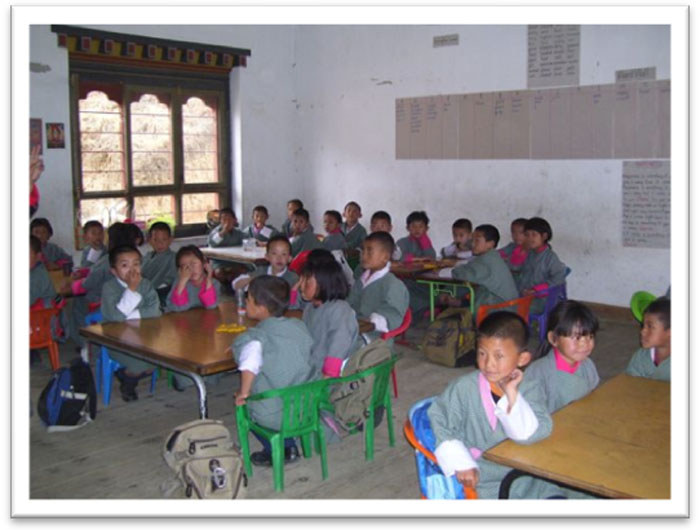
Figure 4. Deki’s class of forty 7-year-olds in Primary 2.
We observed in Deki’s and Dechen’s classrooms prior to the 5-day workshop. The children in both classes were seated around tables. Teaching methods were typical of a transmissive model of whole class instruction, where learning often remained at the level of recitation. Few books or other resources were available. The children knew very little English when they arrived at school, but they were immediately immersed in English instruction. The teachers told us that the children “knew nothing” when they came to school, and their (the teachers’) job was to deliver the curriculum to them.
Members of the children’s families also ultimately played a role in the class projects. The children’s parents and caregivers were not typically welcomed in school because they are perceived as being illiterate with “nothing to offer.” It is not unusual, however, to see parents and caregivers sitting outside the school gate much of the day waiting for their young children (Figure 5).
Figure 5. Parents and caregivers outside the school gate waiting for their children.
Planning and Preparing for the Projects
To begin their preparations for project work, the participating teachers met with the researchers after school to plan ways to implement what they had learned from the workshop (Figure 6).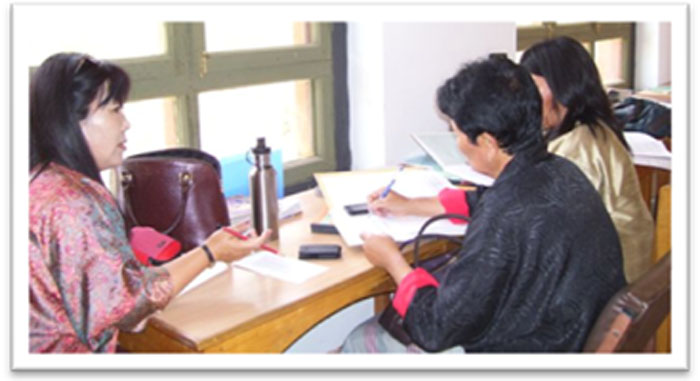
Figure 6. Teachers meeting with researchers to plan their projects.
Deki and Dechen expressed the feeling that they needed to introduce visual representation—specifically, drawing, clay work, and model making—to the children before embarking on a project. We called this process “project preparation.”
The teachers both began by introducing observational drawing to their classes. Dechen brought in flowers and plants from her walk to school for her Primary 1 class, and Deki brought vegetables from the local market for her class to draw. The teachers had learned from the workshop that children needed uncluttered and aesthetically pleasing spaces for doing artwork or making visual representations such as sketches and drawings. They made some changes in the classrooms to accommodate this need. On the day that the teachers were to introduce drawing, all of the children’s school bags were put outside the classroom, and the tabletops were cleared off, except for the drawing materials (Figure 7). The walls were also readied to display the children’s drawings. Old cans were covered with Bhutanese fabric to hold the art materials (Figures 8 & 9).
It had been suggested that teachers not demonstrate how to draw but rather talk with the children and encourage discussion among them about what and how they were drawing.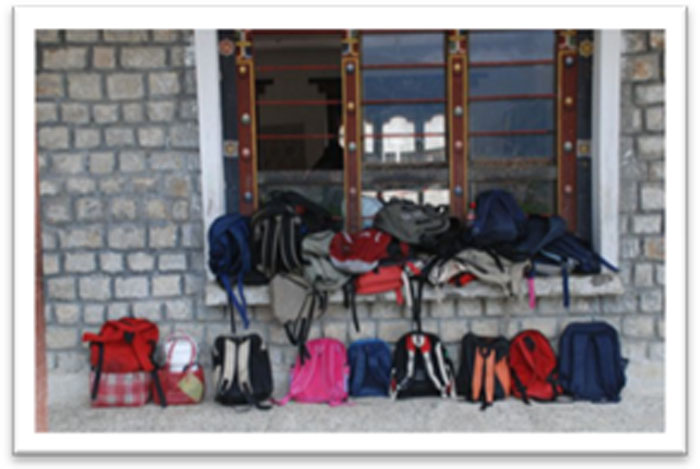
Figure 7. Bags stacked outdoors to make space for drawing. 
Figure 8. Cans covered with Bhutanese fabric.
Figure 9. Uncluttered walls and tables.
Introducing Visual Representation to Children
The project preparation with both Dechen’s and Deki’s classes entailed observational drawing and sketching, clay work, and construction of 3-dimensional models.
Observational Drawing
The 6-year-olds in Dechen’s Primary 1 class made drawings of flowers gathered from around the school (Figure 10). Their drawings demonstrated keen observations as well as confident drawing skills (Figures 11-14).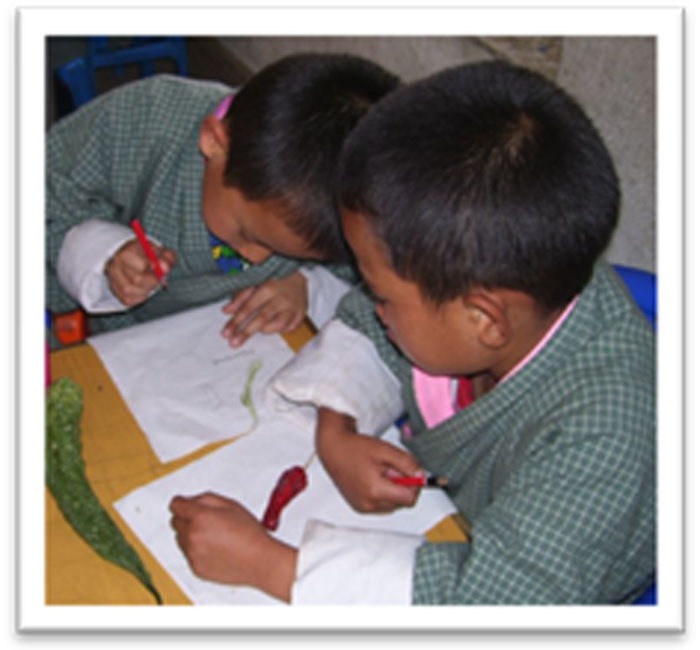
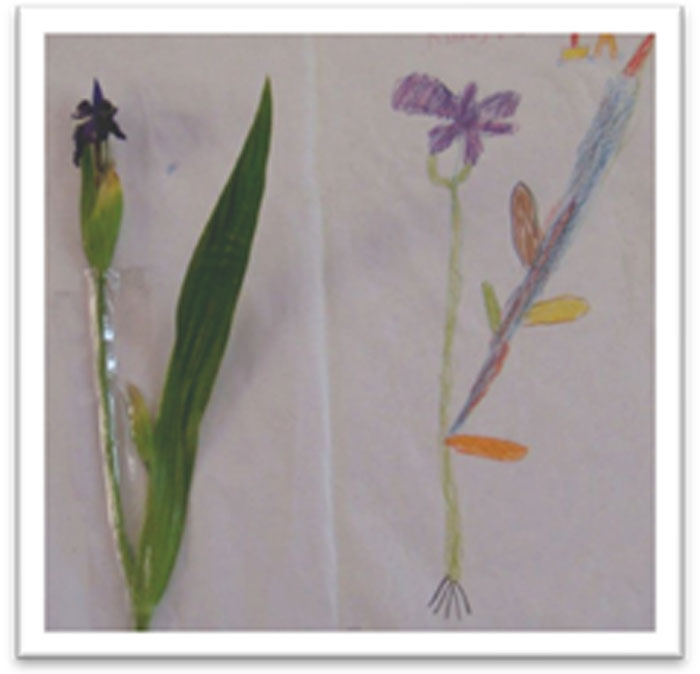

Figures 11-12. Drawings of plants by 6-year-olds in the Primary 1 class.
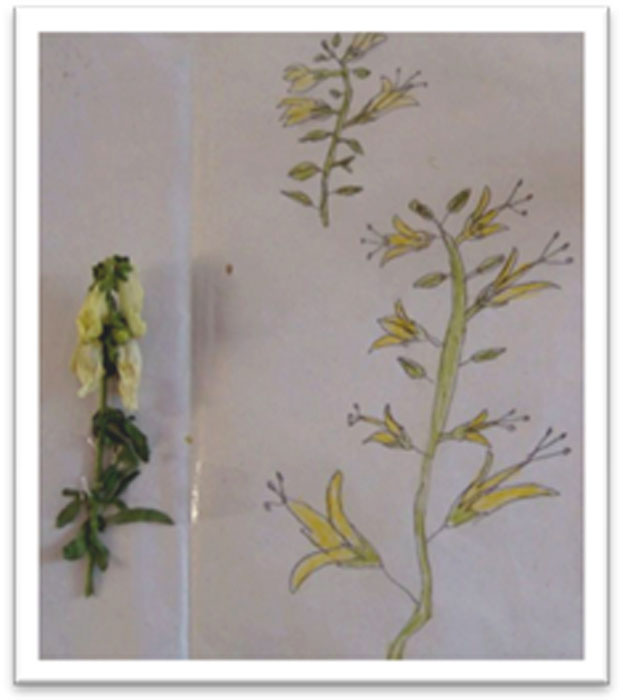

Figures 13-14. Drawings of plants by 6-year-olds in the Primary 1 class.
The children in Deki’s Primary 2 class also drew with great proficiency (Figures 15-16). A collage made from cut-outs of vegetables that they drew was mounted on the wall (Figure 17). The teachers noted that as the children drew, they discussed what they knew and what they noticed about the vegetables and flowers, and they labeled their drawings.
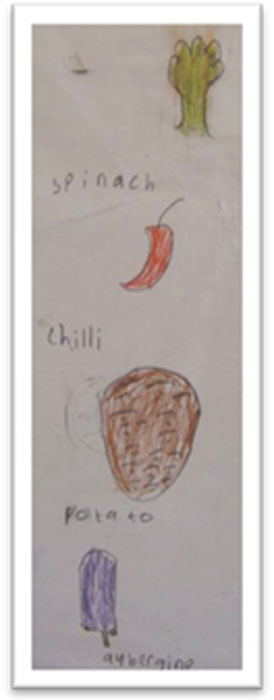

Figures 15 & 16. Primary 2 observational drawings of vegetables.
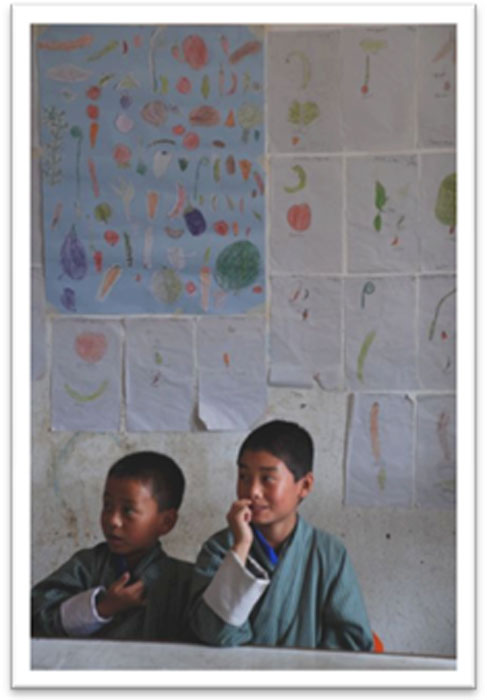
The teachers expressed surprise at the children’s high level of engagement (Figures 18 & 19) and the quality of their drawings. The children’s intense focus gave the teachers time to engage in discussions with small groups and individual children, which in turn enabled them to appreciate how much knowledge the children brought to the task.
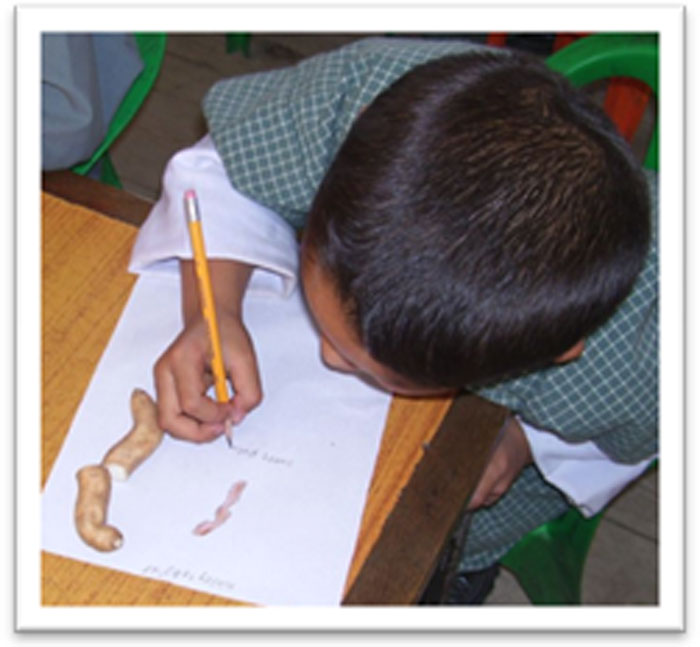
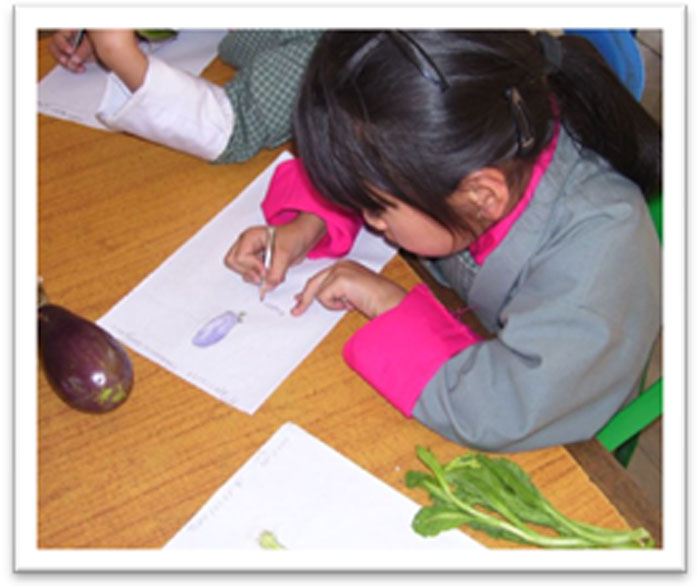
The teachers and the researchers reflected that they noticed a “mindfulness” to the children’s drawing that fit well with the principles of Buddhism and Gross National Happiness.
Clay Work
Deki and Dechen also planned experiences for the children that involved 3-dimensional visual representation. They wanted to have their classes work with clay, which meant using local funds of knowledge. The teachers did not know where to get the best clay for clay model making or how to prepare it, so they had to turn to the families in order to find sources for the clay and to prepare it.
The teachers brought bags of dry clay from the fields and enlisted the help of parents to prepare the clay for modeling purposes (Figures 20 & 21). 
Figure 20. Parents mixing the clay with water and kneading it.
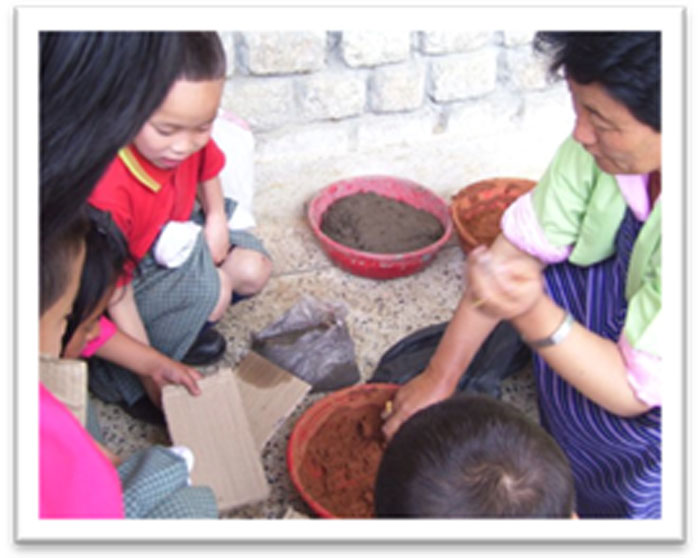
Figure 21. Clay stored in bowls and portioned out.
The Primary 2 class worked with clay outdoors (Figure 22). Each child had a cardboard square for the clay. Primary 1 children worked at tables indoors (Figure 23). They integrated other materials into their clay constructions, such as wool, cloth, and sticks.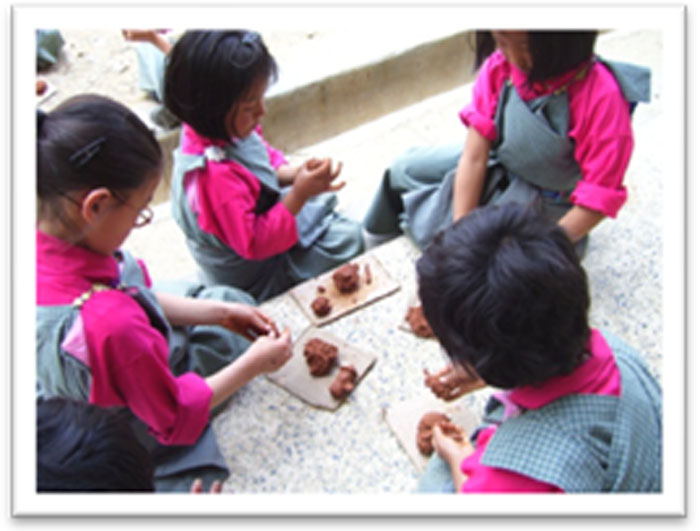
Figure 22. Primary 2 girls working with clay outdoors.
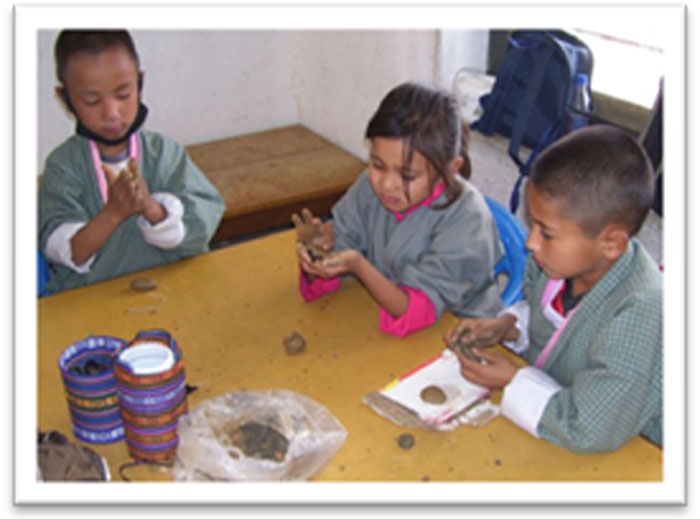
Figure 23. Primary 1 children shaping clay at a table.
One of the boys indicated that he wanted to make a representation of an elephant from clay. He made one that was several inches long and painted it a color he referred to as “ash color” (Figures 24 & 25).

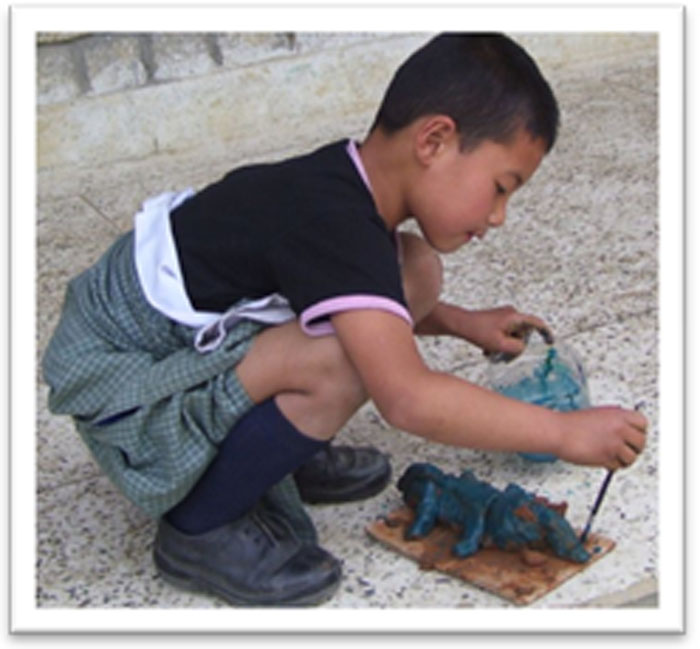
Figures 24 & 25. Constructing and painting a clay representation of an elephant.
The open-ended nature of the clay activity was at first challenging for the children, who were accustomed to much direction from adults. Eventually, however, they began to explore the properties of the clay, and soon representations of objects, figures, and animals from their everyday life began to emerge. The children faced many technical problems in the process of working with clay. Through trial and error and much discussion, they were able to share solutions and ideas with each other.
Model Making
The final part of project preparation was construction of 3-dimensional models. By the time the children undertook the model-making practice, the teachers and children were all adapting well to their new tasks and responsibilities. The teachers indicated that they found the children to be increasingly independent and creative; the teachers themselves relaxed into their new roles as guides, collaborators, and managers (Figure 26).

Figure 26. The teacher (seated, center) working alongside the children.
The children collaborated on construction of increasingly complex models using a wide array of materials, including cardboard boxes, sticks, and paper (Figures 27 & 28).


Figures 27 & 28. Children collaborating to construct models.
We noted that the “project practice” seemed to give teachers and children alike the skills, dispositions, and confidence needed to undertake a project. The teachers were able to see for the first time that if they provided a flexible structure and guidance rather than direction, then they and the children could share responsibility for decisions regarding what to learn about and how best to learn it. The teachers also realized that they had seriously underestimated the capabilities of the children. In terms of the action research project, the results of these activities also demonstrated that such project preparation, including practice in visual representation, might be a necessary part of teacher training in Bhutan.
Project Work: Phase 1
The teachers selected project topics based on the children’s interests, the local funds of knowledge and resources (including where the children’s parents were employed), the curriculum to be covered and—most importantly—available opportunities for firsthand investigation.
Dechen chose a study of “Places in and around the School” for her Primary 1 class project. Deki chose as a topic the “Gangtey Hotel,” situated just up the road from the school. The hotel, a former palace and one of the oldest buildings in Paro, employed some of the children’s parents, who might be able to help the children with their information gathering and representations of the hotel during the project.
The next step was the creation of topic webs to help the teachers and the children visualize aspects of the topic that might develop during the project. Each teacher created her own web and worked with the children in her class to create the web reflecting the children’s knowledge and questions (Figures 29-31).
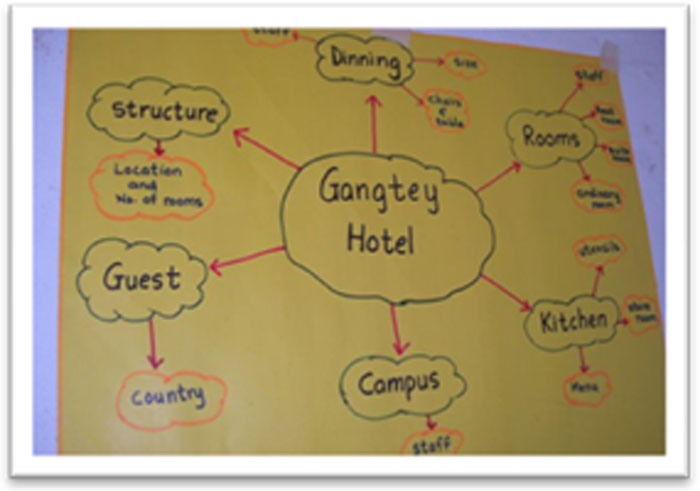
Figure 29. The teacher’s topic web for the Primary 2 Gangtey Hotel project.

Figure 30. Section of the web created on the chalkboard in collaboration with the class.
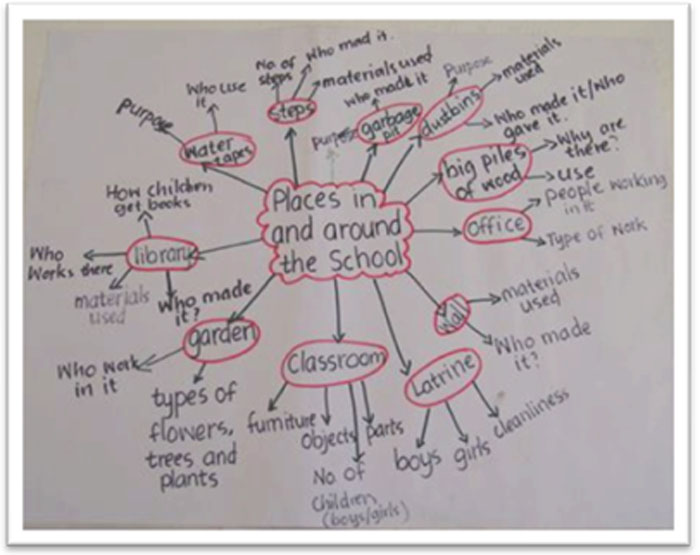
Figure 31. The Primary 1 children’s web for the project “Places in and around the School.”
Stories about the Topics
The teachers then gathered information about what the children in their respective classes already knew about the topic. The children shared stories and drew pictures related to the topic. Finding out what children already know was a new concept for the teachers, who expressed surprise that the children already knew so much about their topics. The teachers reflected that they gained insights into the children’s everyday lives, their families, friends, and neighborhoods.
Memory Drawings and Writing about the Topic
Next the children in each class drew all they knew about the topics. They were also able to write short sentences. The teachers mounted the drawings on their classroom walls and created collective catalogs of information about the topics for the class (Figures 32-35).


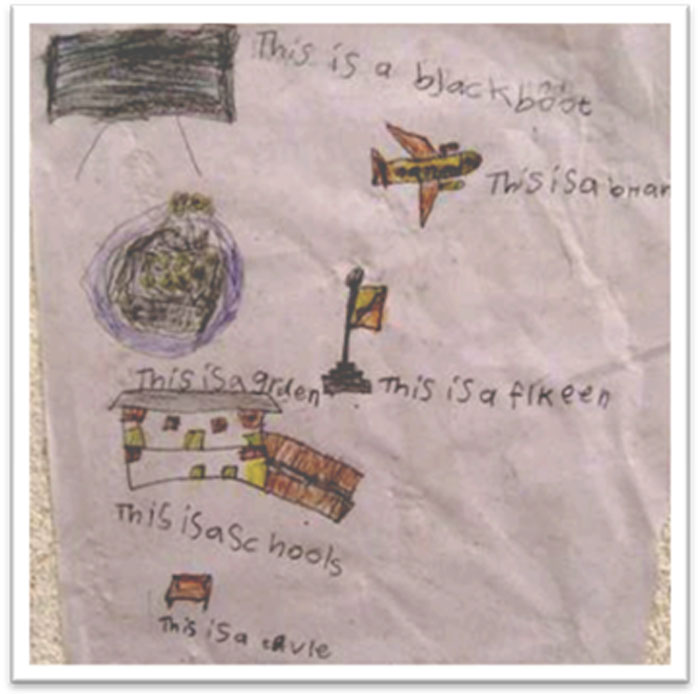
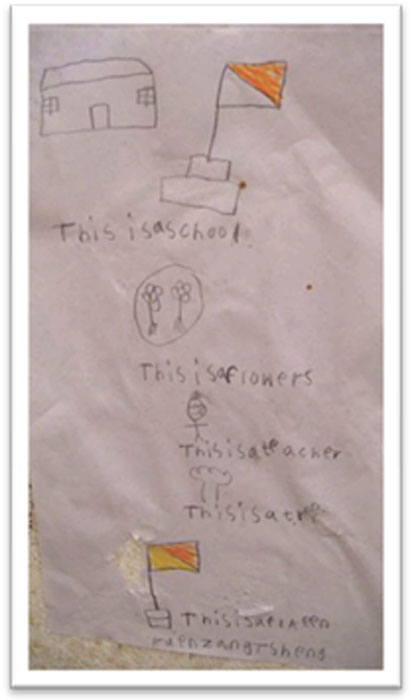
Figures 32-35. Primary 1 children’s memory drawings of the school and things around it.
Raising and Writing Questions
Documenting what the children already knew made it easier to identify what they did not know and what they wanted to know more about. Together the teachers and children wrote some of their questions in their project folders (Figure 36) and on the chalkboard (Figure 37). The children rehearsed how they might interview someone on the site and wrote some of the questions that they would ask.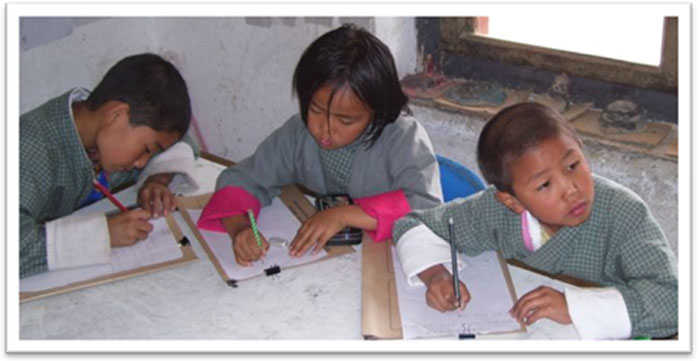
Figure 36. Children in Primary 2 writing questions to take on their field visit.
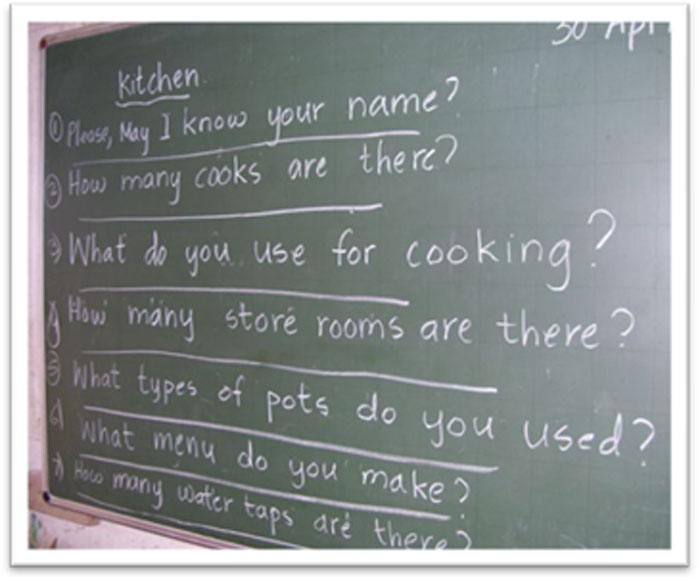
Figure 37. Questions from Primary 2 children for the Gangtey Hotel kitchen staff.
Preparing for Fieldwork
The teachers and children in these classes had never done fieldwork, so the researchers spent considerable time with the teachers planning how it might be done, beginning with visits to the field sites. It was important for the teachers to meet first with the personnel working at the sites, to see how the children’s questions might be answered and to determine whether the staff had any concerns about children visiting their places of work.
Next, the teachers helped the children select their own study or subtopic groups according to the subtopic headings from their “mind maps” or topic webs. For example, in the Primary 2 class, six groups of six or seven children investigated specific parts of the Gangtey Hotel—the kitchen, the dining room, the building, the bedrooms, the garden, and the reception area. Each group had a list of tasks to do, information to collect, and questions to answer. In their groups, the children discussed what they thought they might see and do. The teachers and children also reviewed firm guidelines for appropriate behavior for site visits.
Lecturers from the college and parents from Deki’s and Dechen’s classes were brought into the process. The researchers and the teachers informed them about how best to support the children doing fieldwork. One adult was assigned to support and supervise each group. Each was given the list of things typically done on a field visit—sketching, rubbings, measuring, counting, processes identified and recorded, diagrams, writing, interviews, and items to bring back to share with the classes.
Project Work: Phase 2
The teachers and the children then undertook the fieldwork for their respective projects. Annotated photo stories follow, showing the Primary 2 class at the Gangtey Hotel and the Primary 1 class investigating the school.
Fieldwork at the Gangtey Hotel
The Primary 2 class began by reviewing what was expected of them on their visit to the Gangtey Hotel, both in terms of behavior and data collection (Figure 38). They then assembled their clipboards, pencils, and questions to take with them (Figure 39).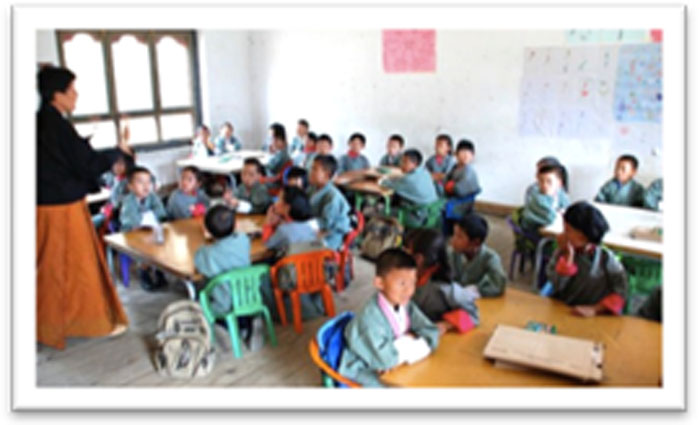
Figure 38. Reviewing the expectations.

Figure 39. Assembling materials to take on the field visit.
The children lined up in groups outside classroom to walk to the hotel (Figure 40). When they reached the hotel, they waited outside for the manager to welcome them (Figure 41).
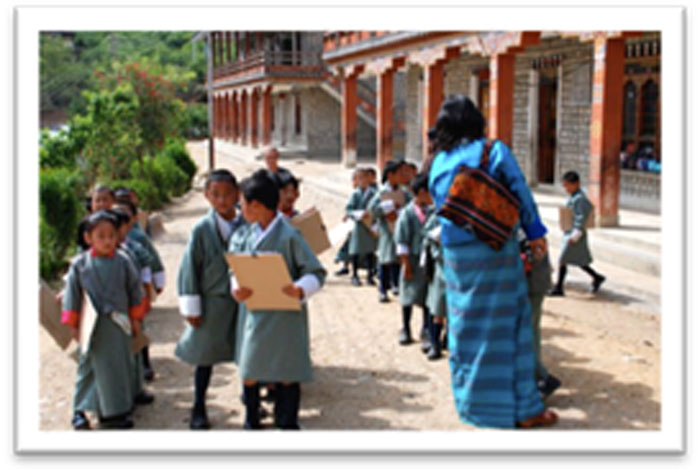
Figure 40. Primary 2 children lining up to walk to the Gangtey hotel.
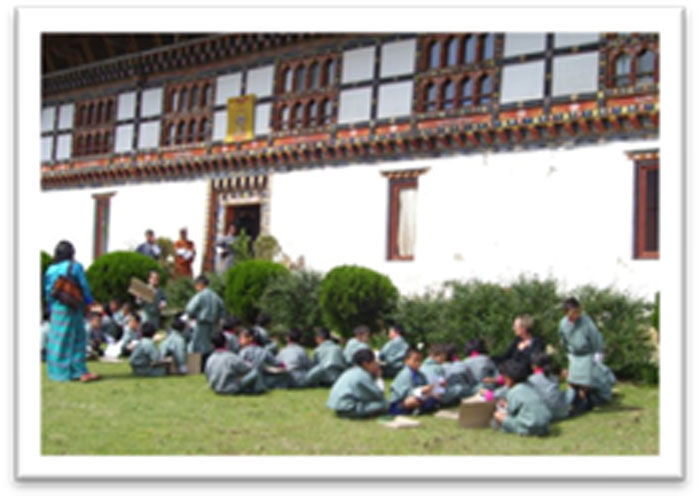
Figure 41. Children waiting in small groups outside the hotel.
In the hotel garden, children from one of the small groups (the “garden group”) drew the chorten (a Buddhist monument) and measured it by counting paces (Figure 42). They also created a pictorial map of the hotel garden, including the chorten (Figure 43). Members of the group also undertook focused independent observational drawing of the gardens, which would be used to create a 3-dimensional representation of the gardens upon their return to the school (Figures 44 & 45).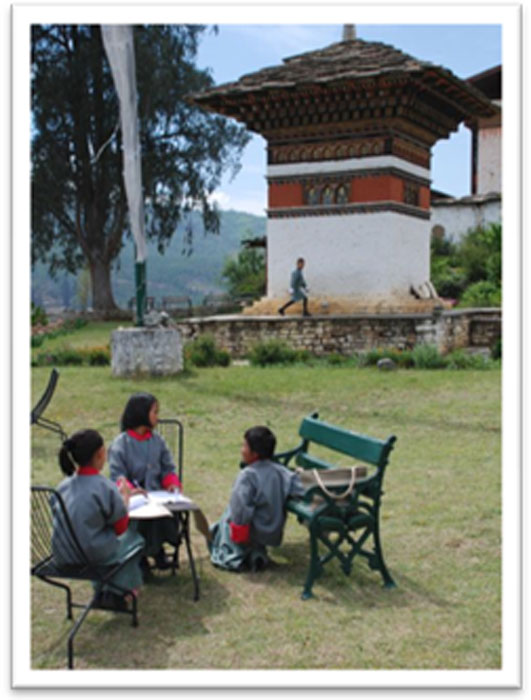
Figure 42. Drawing and measuring the chorten.
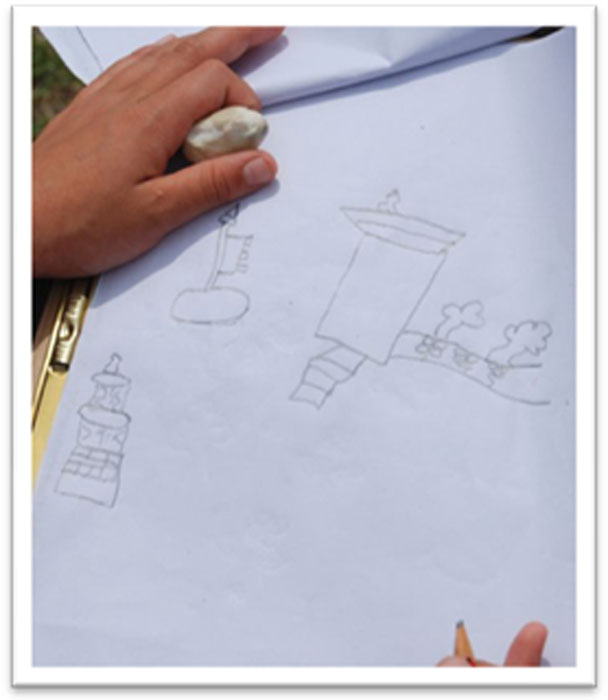
Figure 43. Creating a pictorial map of garden.


Figures 44 & 45. Making independent observational drawings of the gardens.
The group studying the hotel dining room interviewed a waiter about his work and his customers. They recorded his answers to their questions and drew a portrait of him (Figures 46 & 47).
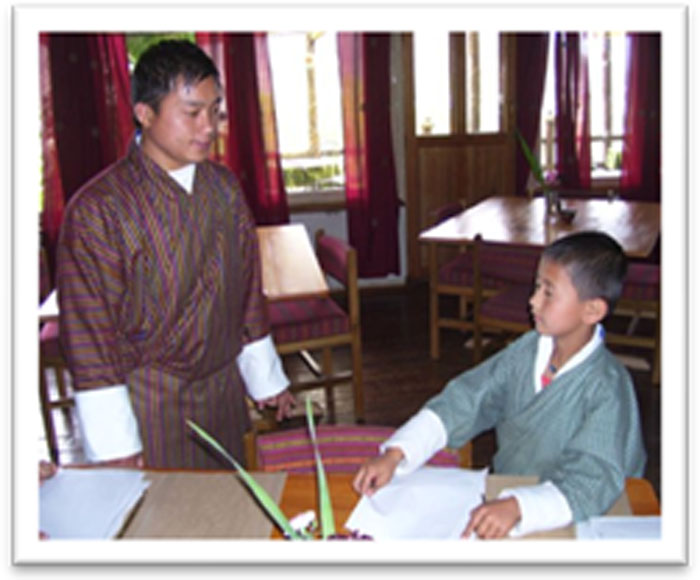
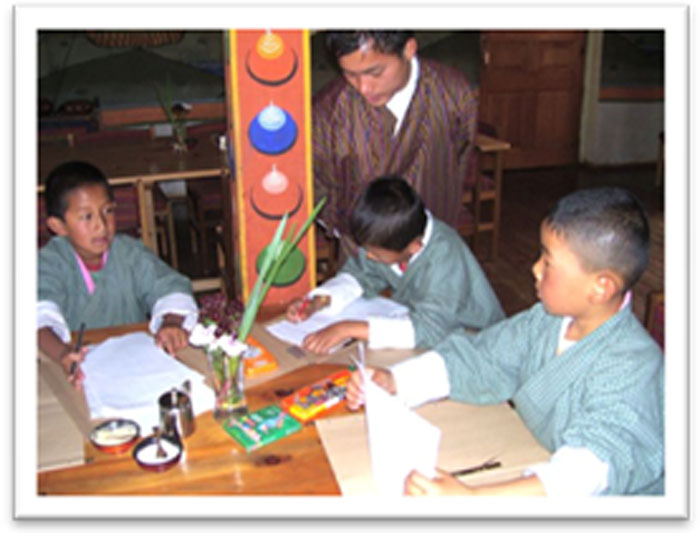
Figures 46 & 47. Interviewing the Gangtey Hotel waiter and drawing his portrait.
Children in the dining room group also measured the size of the room in paces and tabulated the number of tables and chairs (Figures 48 & 49.)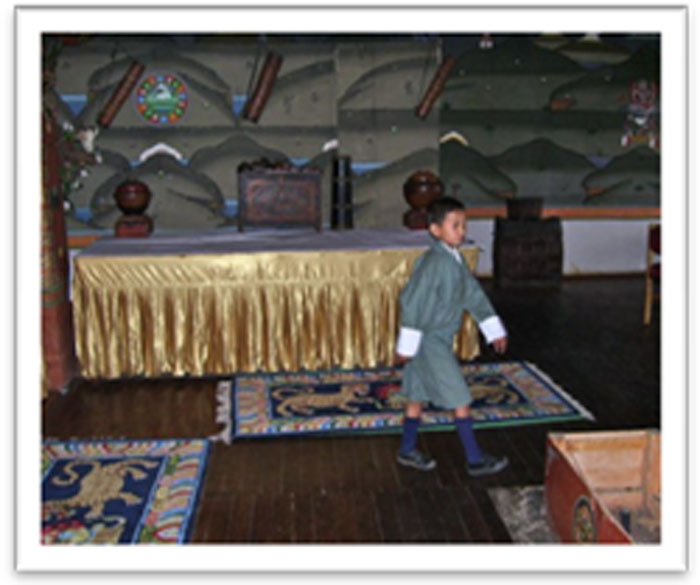
Figure 48. Pacing out the size of the dining room.
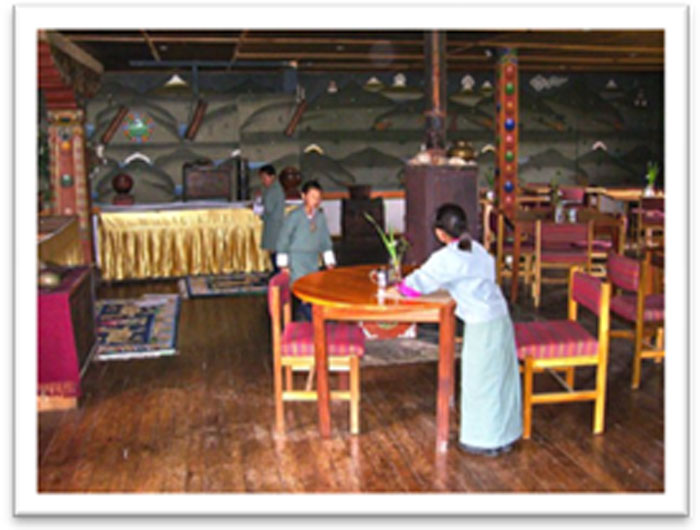
Figure 49. Counting tables and chairs.
Observational drawings made by the dining room study group included drawings of tables and chairs (Figure 50) as well as useful and decorative items, such as the rice box, a set of ladles, and a wine flagon (Figure 51).
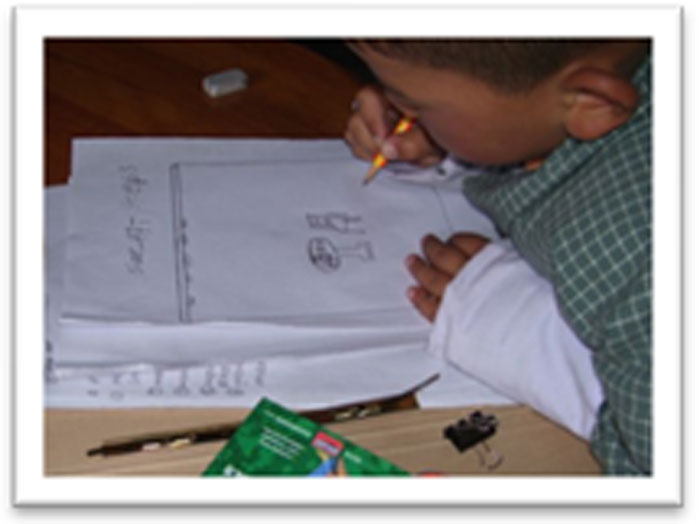
Figure 50. Drawing the tables and chairs.

Figure 51. Drawing the rice box, ladles, and wine flagon.
One of the Primary 2 groups investigated the Gangtey Hotel kitchen (Figure 52). They counted and drew the gas stoves in the kitchen (Figure 53), observed the chef at work, and interviewed him.

Figure 52. View of the Gangtey Hotel kitchen.
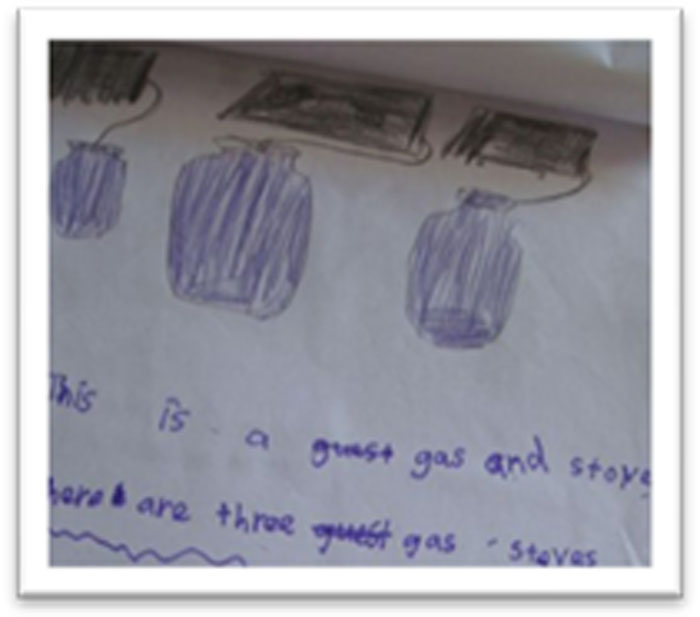
Figure 53. Labeled drawings of the gas stoves.
Some of the children recorded information for a visual catalog about cooking ingredients used in the kitchen, how they were stored, how the chef used them, and the tools that were needed for preparation of food (Figures 54 & 55.)

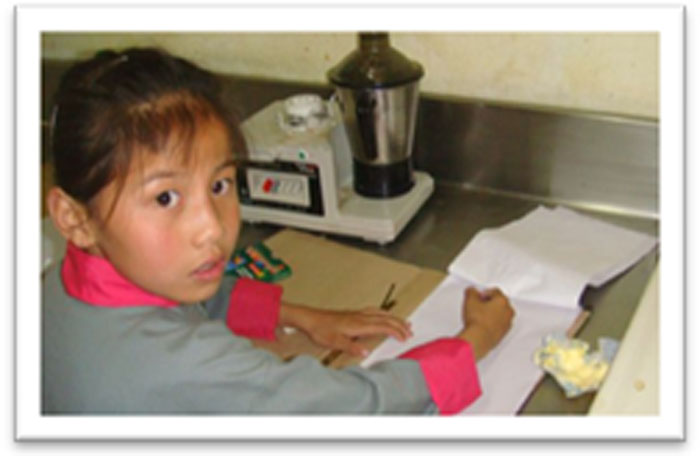
Figures 54 & 55. Recording information about food preparation.
Another group investigated the reception area (lobby) of the hotel. They interviewed the hotel receptionist about several topics, including the hotel’s history, the people who work in the hotel, the people who stay at the hotel, and where the hotel’s guests might come from (Figure 56).
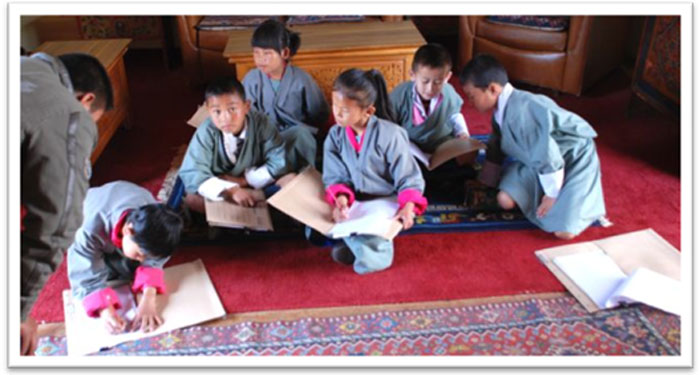
Figure 56. Interviewing the hotel’s receptionist.
The hotel reception area featured a number of clocks that showed the time in different parts of the world (including “New York, America”; “Tokyo, Japan”; and Paro, their local community). Some of the children were particularly interested in the clocks and made drawings that showed the differences among them (Figures 57 & 58).
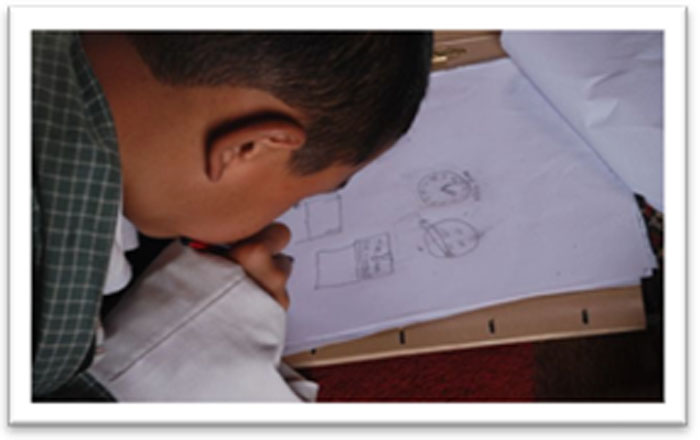
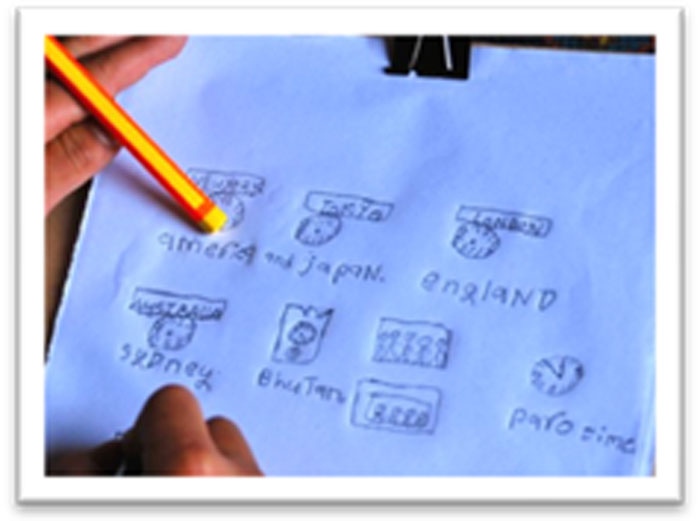
Figures 57 & 58. Drawing the clocks in the hotel lobby.
The bedroom study group gathered data in the guest rooms. They measured beds, tried out the mattresses, and drew what the beds looked like (Figure 59).

Figure 59. Collecting and discussing data about a bed.
Some of the children recorded details about the en suite bathrooms and the contents of cupboards within the rooms (Figure 60). They visited a variety of rooms around the hotel (Figure 61), gathering information that allowed them to compare the different types of rooms and the prices charged for each.
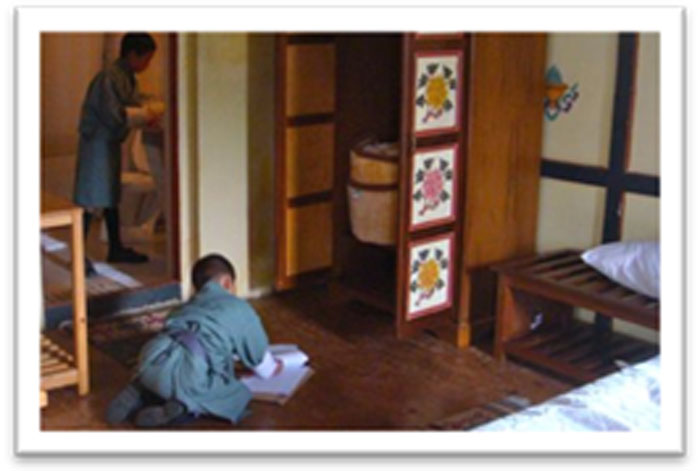
Figure 60. Collecting data inside a room.

Figure 61. Walking between the rooms.
Fieldwork at Taju Primary School
For their project on the school and things around it, small groups of Primary 1 children investigated the classrooms, the library, and the principal’s office.
One group collected data from inside and outside the classrooms, recording information by drawing and labeling what they observed (Figures 62 & 63).
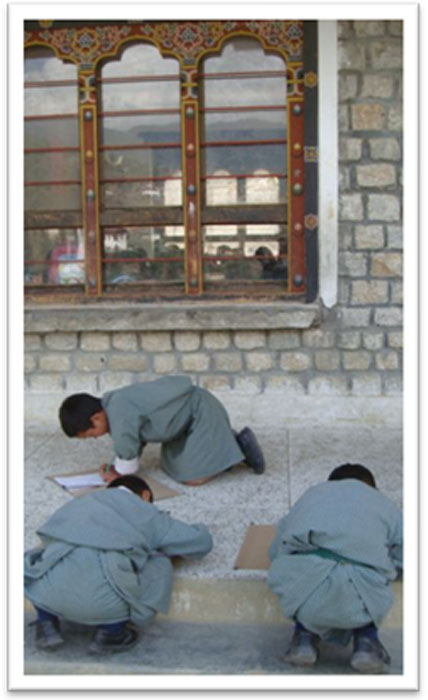
Figure 62. Drawing the exterior of a classroom.
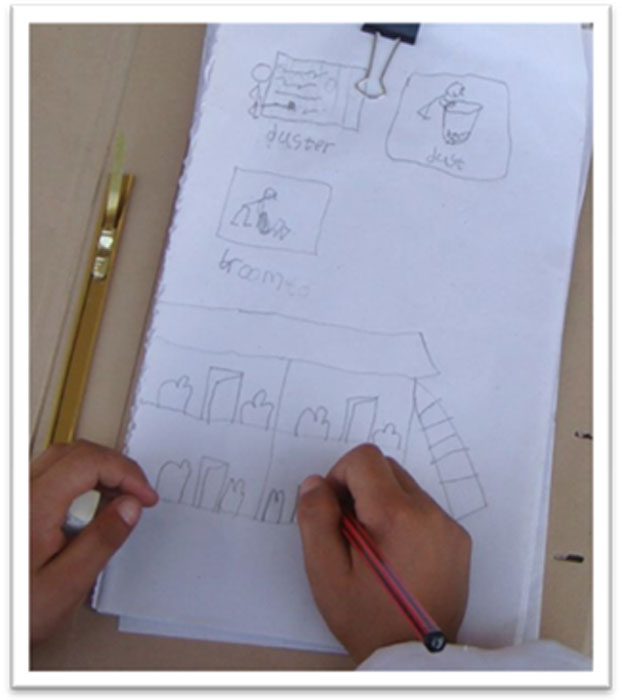
Figure 63. Drawing interior and exterior details.
Another group of children from the Primary 1 class did their fieldwork in the school library. They made observational drawings (Figure 64), counted types of furniture, and interviewed the librarian about her work (Figure 65).

Figure 64. Observational drawing in the library.
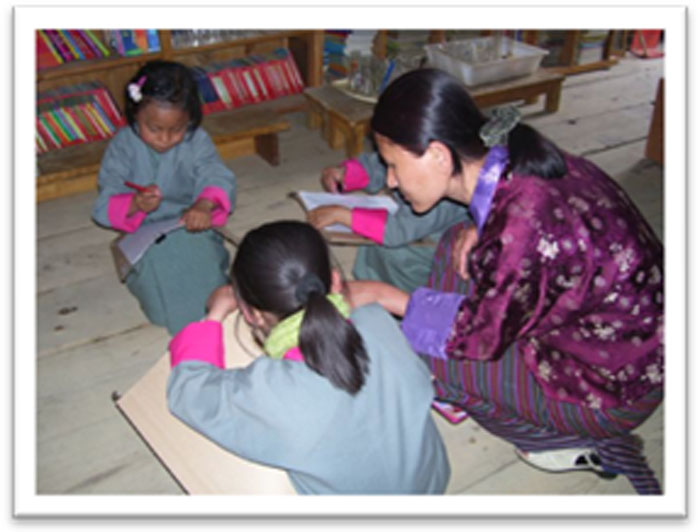
Figure 65. Interviewing the librarian.
Their field notes combined drawings, labels, and responses to questions (Figures 66 & 67).
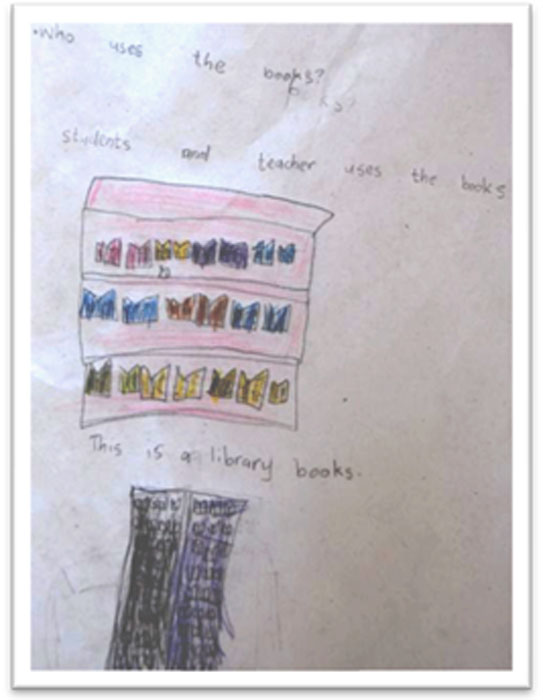
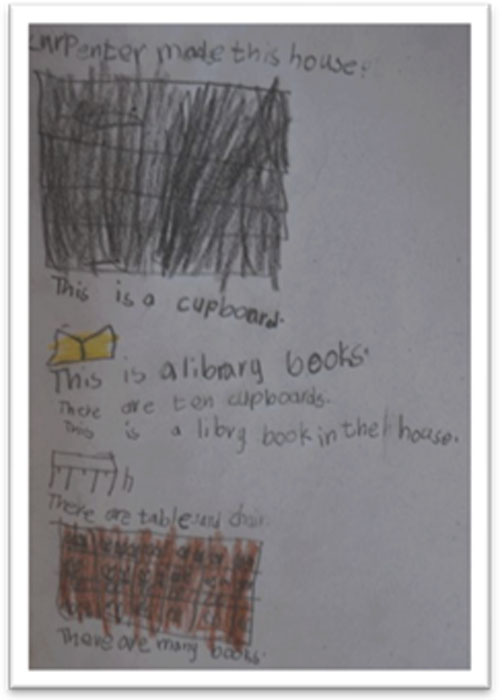
Figures 66 & 67. Field notes from visit to the library.
The school principal’s office was the focus of another Primary 1 subtopic group. The children were given a rare opportunity to meet with the principal, interview him, and make observational drawings of items in his office (Figures 68 & 69).

Figure 68. Interviewing the principal.
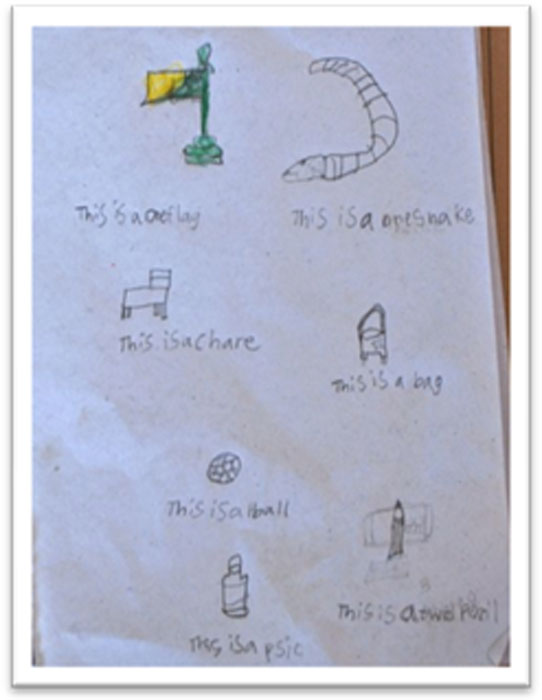
Figure 69. Cataloging the contents of his office.
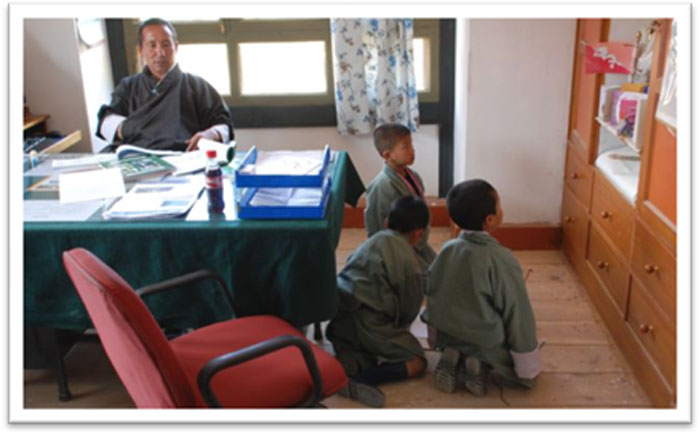
Figure 70. Drawing items in the principal’s office.
During their fieldwork, the children in both classes worked independently and in groups to collect information that was meaningful to them. They were able to communicate with peers and adults, ask questions, discuss discoveries, and share information with each other and with their teachers. The children collaborated with adults to create texts and labels. Measuring and counting activities were integral to their exploration of their sites. Making drawings, field sketches, and notes facilitated a high level of engagement and a focused attention to details over considerably extended periods of time. The hosts at the fieldwork sites remarked that they were captivated and impressed by the serious intensity of the children, their focus, and their attention to detail.
Debriefing after the Field Experiences
The experience of doing fieldwork created strong, personal bodies of knowledge that the children fluently recalled on their return to the classroom. When individuals and groups shared their experiences with the whole class, the children were able to get an overview of the whole project and to understand their own significant part in it. Their knowledge and understandings became evident in the refining, reinterpretation, and representations of the information and experiences that took place after their fieldwork.
The teachers then found themselves interacting in new ways with their classes. Instead of transmitting information and setting prescribed disembedded tasks, they began to elicit information from children, to help them to pose new questions related to their data, and to discuss how groups might undertake the work of representing the findings from their fieldwork.
Visual Representations in Primary 1
The set of photographs below follows children in the Primary 1 class as they began working on their detailed representations.
The children shared personal stories and information gathered during their fieldwork (Figure 71). With the teacher, the various groups made and reviewed their work plans for representing what they had done and learned (Figure 72).
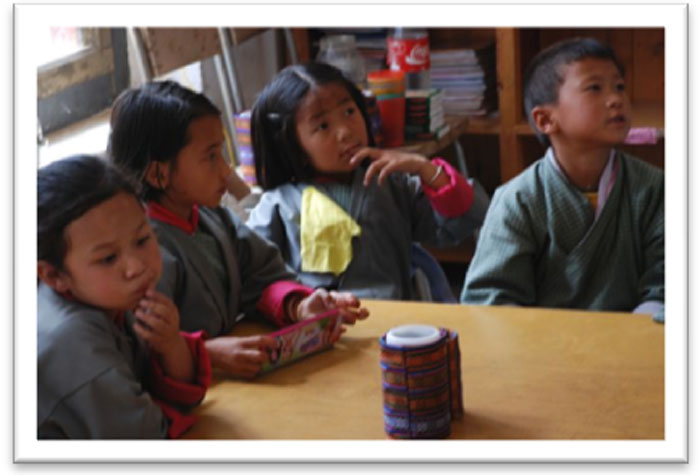
Figure 71. Sharing personal stories from the fieldwork.
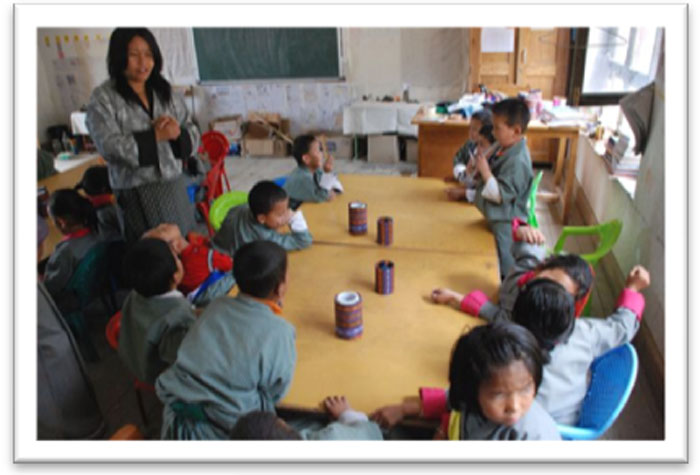
Figure 72. Reviewing each group’s work plan.
Individually and collaboratively, they consulted their field notes, then refined their notes by re-drawing, rewriting, and expanding on their original notes (Figures 73 & 74).
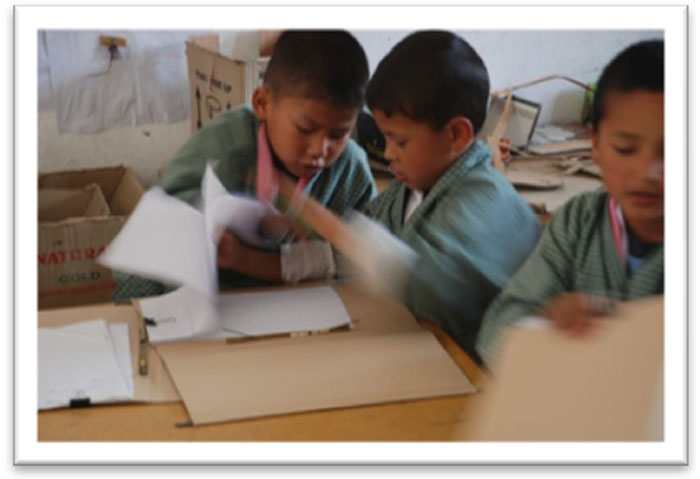
Figure 73. Consulting peers’ field notes.

Figure 74. Re-drawing, rewriting, and expanding field notes.
When the time came to begin work on the representations that would show others their knowledge and understandings of their topics, children who had been appointed “team leaders” helped distribute resources to their subtopic groups. Children from each of the groups began to gather and organize materials for the planned visual representations (Figures 75 & 76).
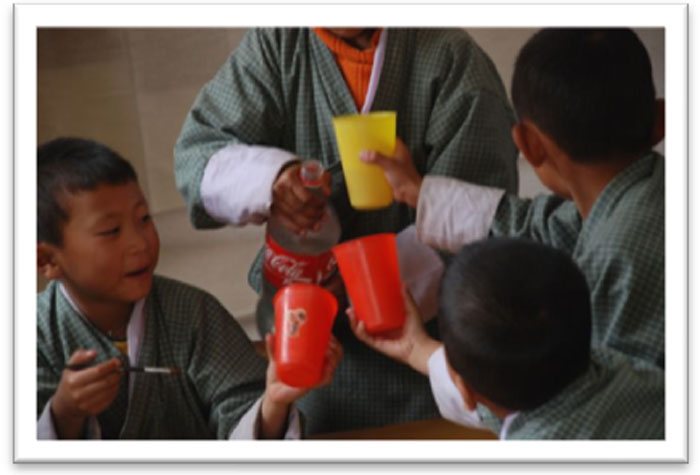
Figure 75. Team leaders handing out resources.
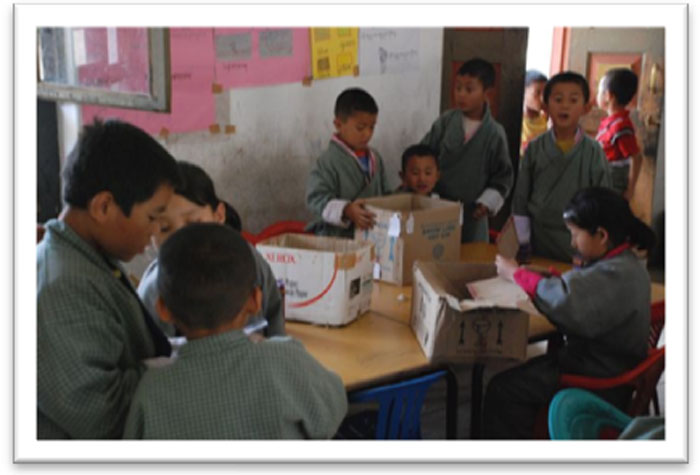
Figure 76. Working groups gather and organize materials.
As the researchers observed the children’s interactions, the story of one particular collaborative effort emerged. Working from their field notes, two girls planned the construction of the library building. They had to measure, estimate, solve problems, and share their ideas (Figures 77-81). Other children made tables, chairs, and bookshelves to furnish the finished building. These processes involved negotiation and the articulation and sharing of ideas and understandings among the participants.
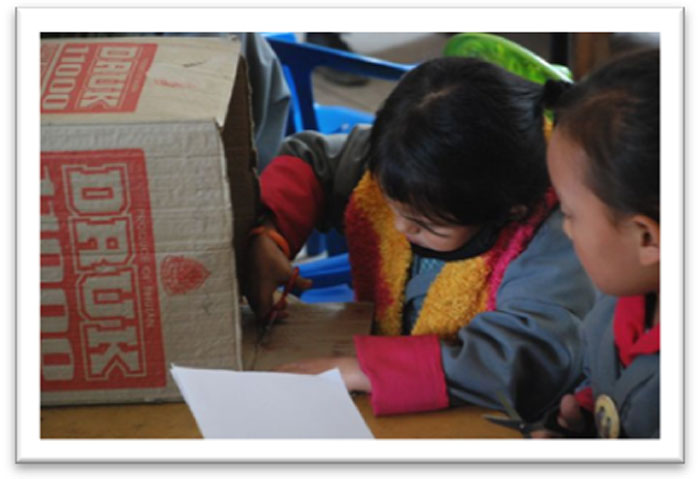
Figure 77. Preparing the box to become the model of the library.
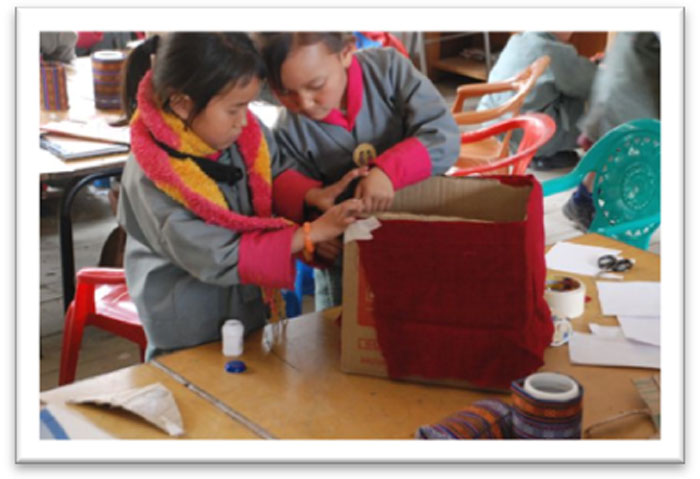
Figure 78. Working closely together.
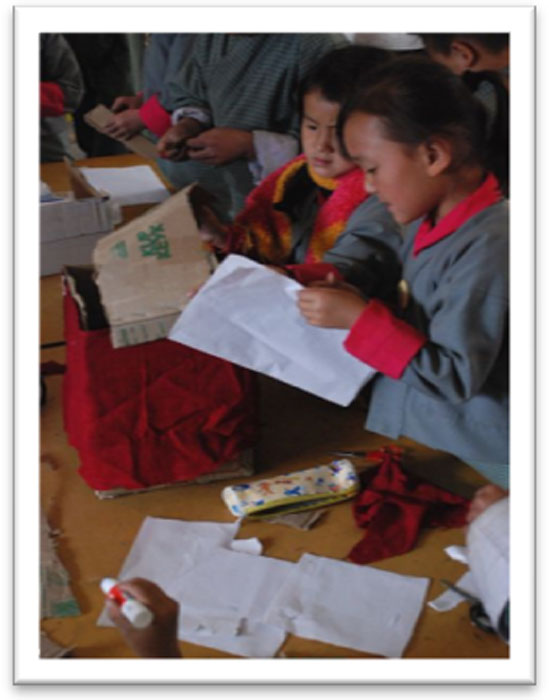
Figure 79. Consulting the field sketch.
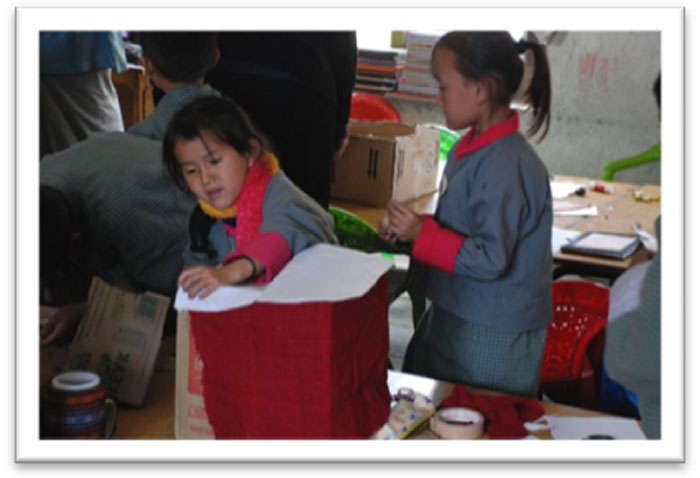
Figure 80. Installing the roof.
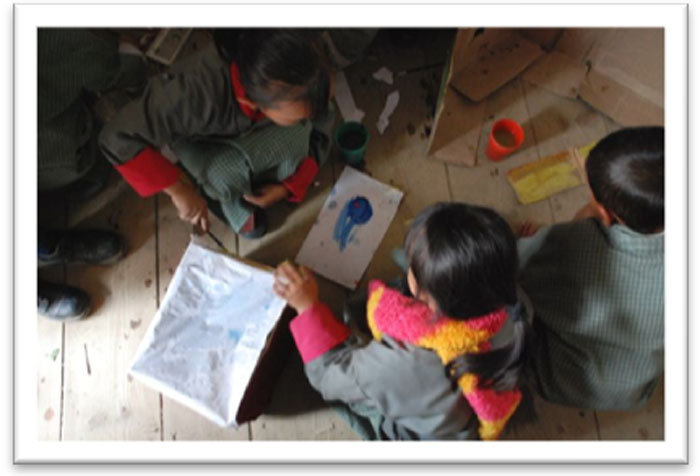
Figure 81. Finishing the model of the library building.
Problem Solving in Both Classes
The teachers and the researchers noted that much problem solving took place among the children in the process of translating and re-creating items from 2-dimensional field sketches into 3-dimensional models using a variety of media. For example, clay proved to be a challenging medium for re-creating the principal’s computer (Figure 82), but clay also proved to be effective at helping to stabilize some structures that the children were building (Figure 83).

Figure 82. Clay representation of the principal’s computer.
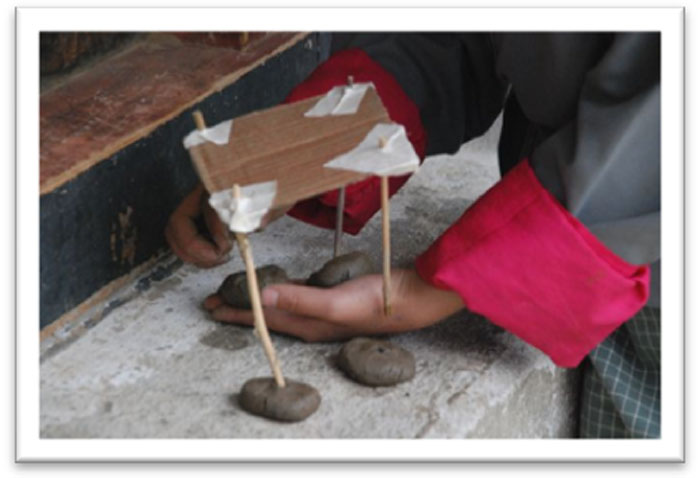
Figure 83. Solving the stability problem.
Creating Displays
Each group was provided a display space for the group’s visual representations of what the children had learned during fieldwork. The teacher and children became involved in much discussion and negotiation about what should be displayed and how to do so. Children collaborated to add components to their displays (Figures 84 & 85).

Figure 84. Adding to the display of work.
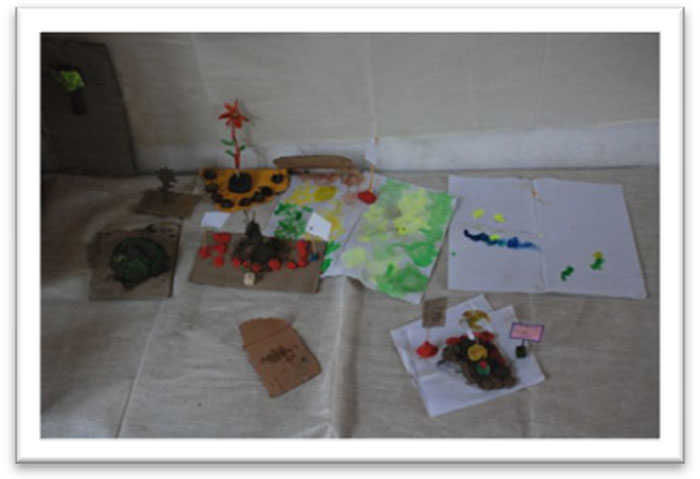
Figure 85. Under construction: Display of school garden group’s work.
Visual Representations and Family Involvement in Primary 2
Deki, the Primary 2 teacher, found a way to bring the parents closer to the classroom and to model how they might become involved with their children’s learning. She found that parents brought deep personal knowledge of the items that the children were trying to create. When the children began working with clay to make their representations (Figure 86), parents and siblings were present to lend support in a variety of ways (Figure 87). (Clay is locally available and accessible to all residents but, we learned, had never before been used in schools in Bhutan.)

Figure 86. Teacher and children discussing clay work.
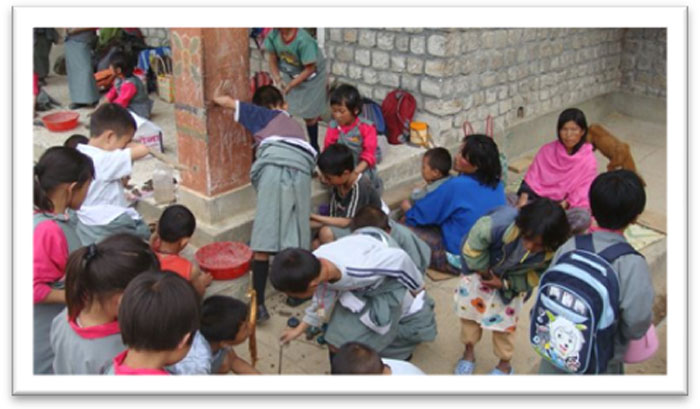
Figure 87. Parents and siblings lending support.
The creation of 3-dimensional constructions seemed to appeal to the children and their families; many children were inspired to make models with their families and bring them to school. Among these constructions were a chair and a building (Figures 88 & 89).

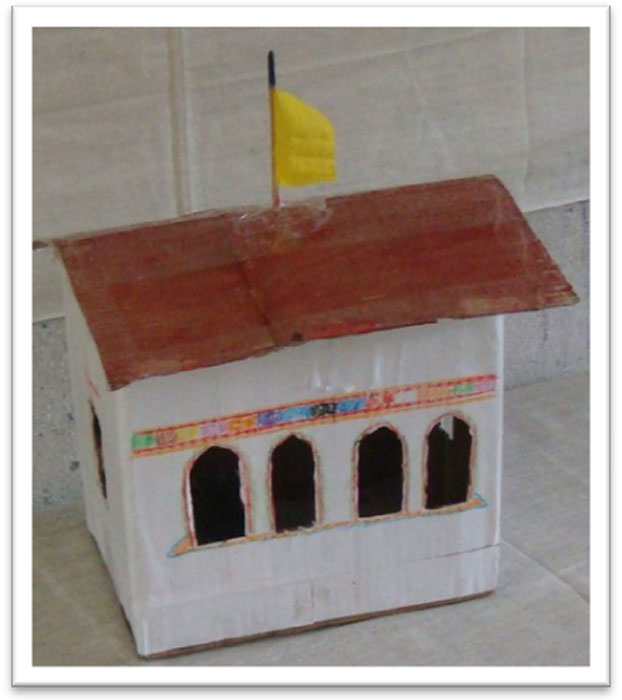
Figure 88-89. Cardboard constructions made by children at home.
Problem Solving with 3-D Representations
Moving from field sketches to 3-dimensional representation created many problems for the Primary 2 children to solve. Their first clay models tended to be fairly flat, including the representations of the chef, the kitchen pots, the stoves, and a person in a bathtub (Figures 90 & 91). They made these flat representations because they could not get the clay creations to stand upright. Working together, however, they discovered that sticking thin sticks into the clay would provide enough support so that their structures could stand upright (Figures 92 & 93).
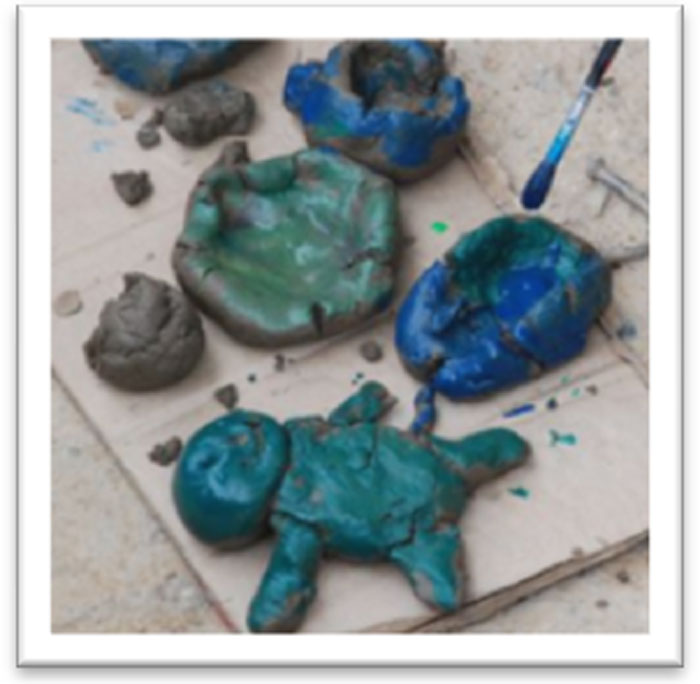
Figure 90. Representations of the Gangtey Hotel chef and the pots in the kitchen.
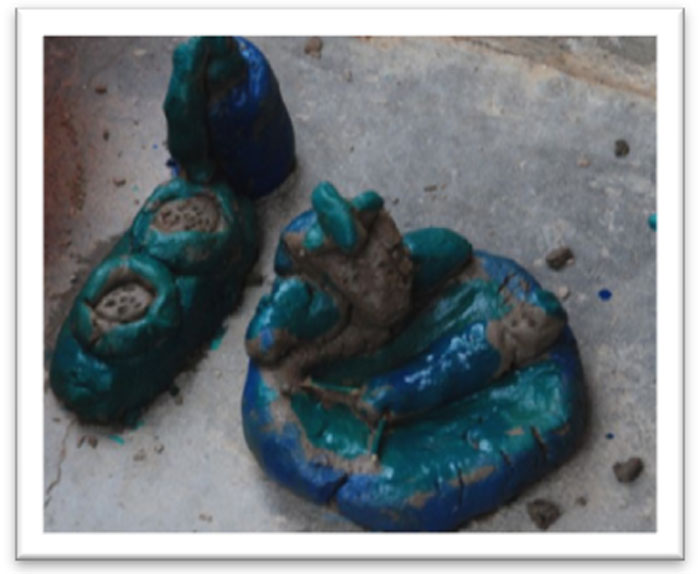
Figure 91. Representations of the stoves and a bath with a person in it.
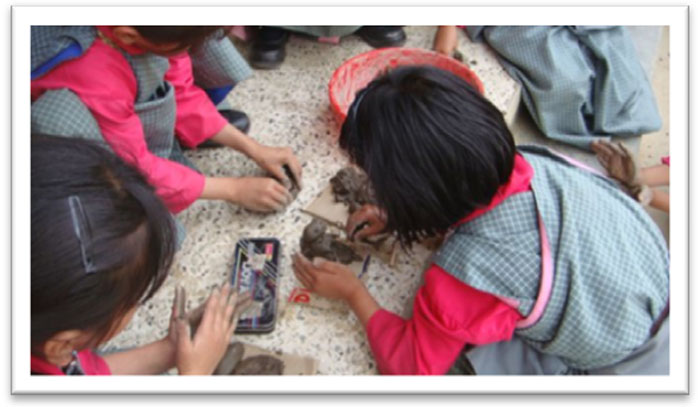
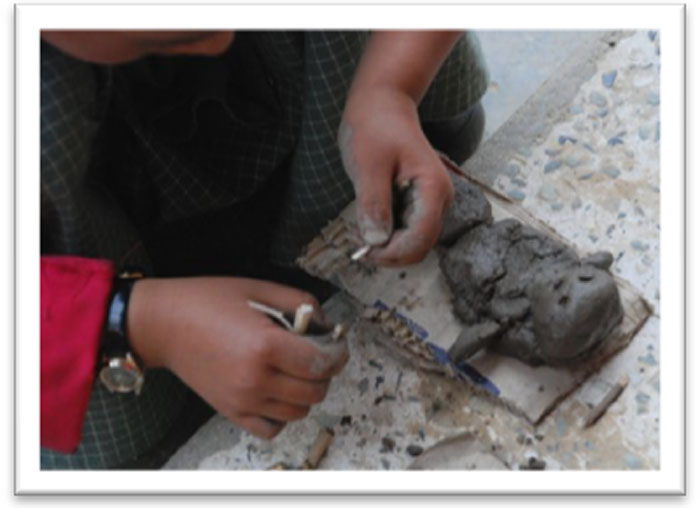
Figures 92 & 93. Putting sticks into the clay to support the figure of the manager.
Another common problem that the Primary 2 children encountered when making representations was the lack of stability of the legs of tables and chairs that they constructed. One child who was having difficulty referred to his field drawing and discovered that tables had cross-braces on their legs. He then created cross-braces for his construction (Figures 94 & 95).
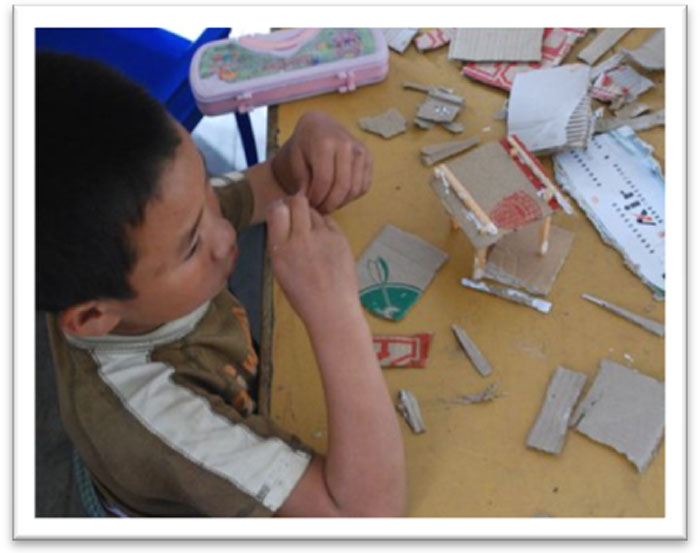
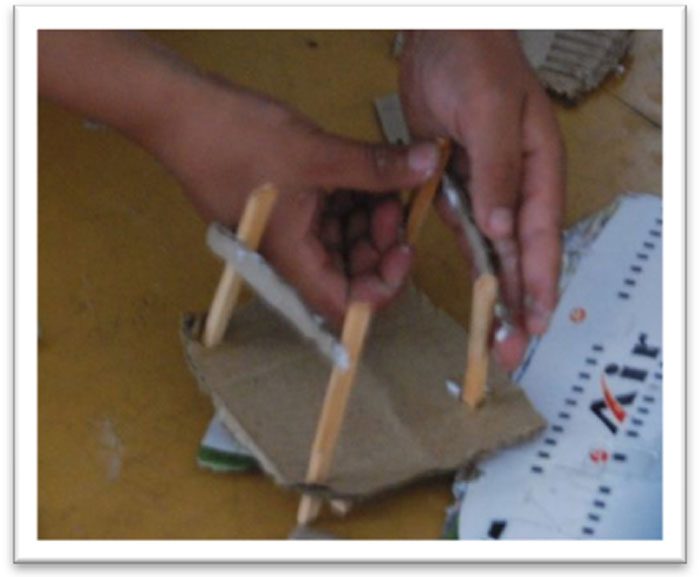
Figures 94 & 95. Enhancing the stability of a table.
Two other boys engaged in much trial and error together to solve the problem of getting a cardboard model of a building to stay upright. They discovered that, like most buildings, it needed a good foundation, so they firmly attached the building to a piece of cardboard (Figures 96 & 97).
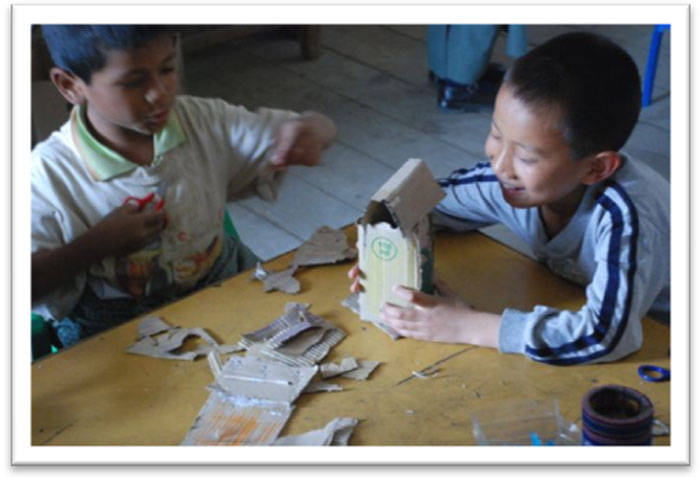
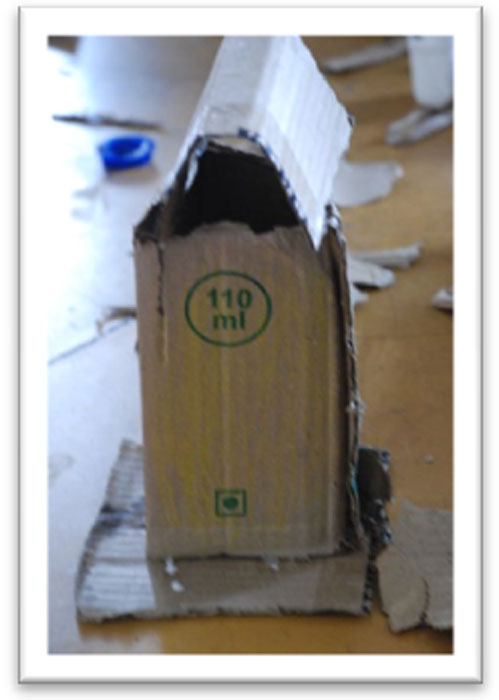
Figures 96 & 97. Stabilizing a building with a cardboard foundation.
Planning and Discussions
The process of creating 3-dimensional representations provided a wide range of opportunities for planning and discussion among the children in the Primary 2 class. Among the occasions for discussion were deciding how to arrange their representations in their displays (Figure 98), working out how best to create figures (Figure 99), and determining how to make sure that their flag and chorten were proportionate to the size of their hotel building (Figures 100 & 101).
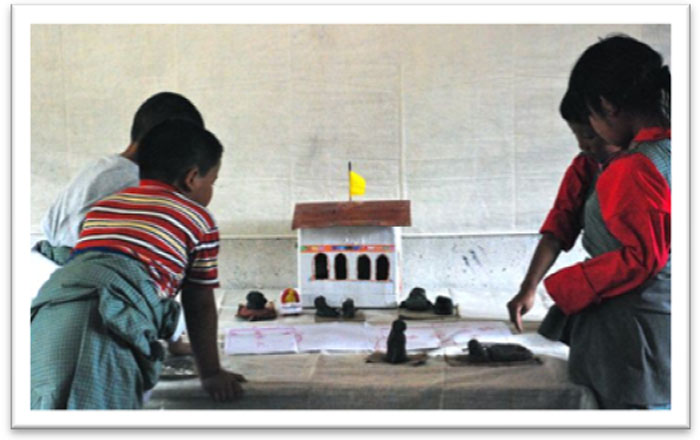
Figure 98. Planning the display.
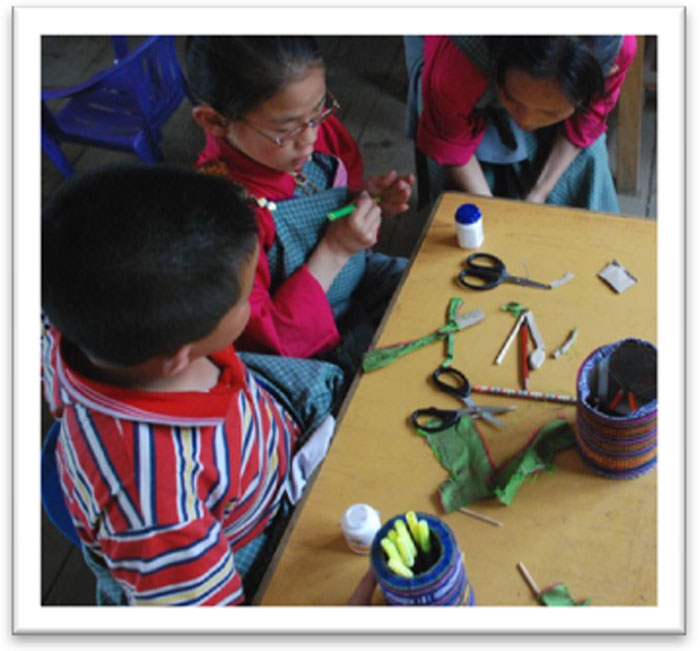
Figure 99. Discussing ways to create figures.


Figures 100 & 101. Making sure the flag and chorten are in proportion with the hotel building.
Researchers’ Reflections on Phase 2
As demonstrated in the photographs above, we observed a remarkable shift in the kinds of activities and thinking in which the Primary 1 and Primary 2 children were involved. The children moved from a position of being dependent on the teacher for direction and knowledge to one of engaging in creative thinking, information gathering, discussion, and problem solving. Each activity contributed to creation of a community of learners that engaged and extended each child’s interests, capabilities, and disposition to learn. The collective knowledge was “more than the sum of its parts”; in this collaborative and constructive environment, new and meaningful knowledge was being created all the time.
The children seemed to be highly self-motivated by this style of learning; they worked on their projects in every spare moment they could find. The authors and the teachers observed children in both Primary 1 and Primary 2 taking risks, experimenting, and sharing ideas. The children’s interest in topics that built on local knowledge and resources provided strong links between home and school—links that are missing in most Bhutanese primary schools. The Project Approach opened up a whole new way of learning for them; the teachers reported that children would ask them each day when they could next do project work.
Phase 3: Presenting Project Work to Others
Phase 3 of both projects involved the children in presenting the work that they had done for other people. The teachers invited the researchers, the school principal, other teachers from the school, and parents to view the finished displays of the children’s work. Each of the small groups presented a verbal summary of the children’s work on their projects.
In the Primary 1 class, for example, the group that focused on the school garden created a 3-dimensional display with written documentation (including an account of an interview with the gardener), a map of the garden, and model garden plots with clay plants (Figures 102-104).
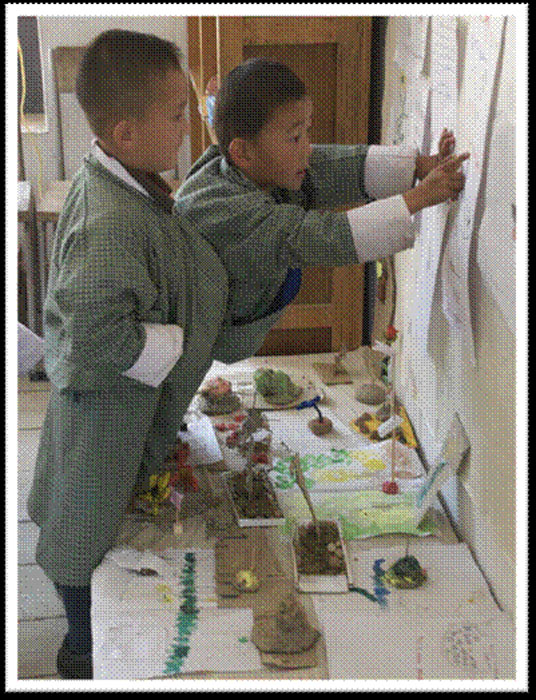
Figure 102. Reading an account of the interview with the gardener.

Figure 103. Wall display created by the Primary 1 group studying the garden.
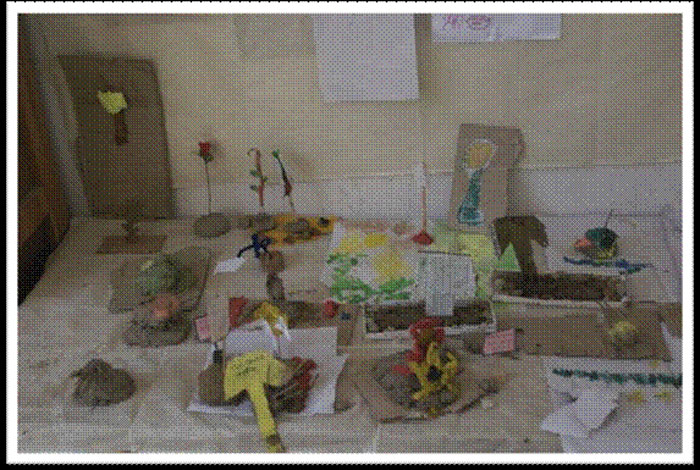
Figure 104. Finished garden display created by Primary 1 children.
The children in the Primary 2 class also combined 3-dimensional and written work in their displays related to the Gangtey Hotel. The displays included books made by the children, labeled drawings, and interviews. The children also created detailed arrangements of their models representing the hotel grounds and buildings (Figure 105), the bedrooms, the kitchen (Figure 106), the dining room, the reception area, and the hotel employees (Figures 107 & 108). Many of the models included detailed furnishings (Figure 109).

Figure 105. Primary 2 children’s representations of the hotel grounds and buildings.

Figure 106. Representations of the hotel bedrooms and kitchen.
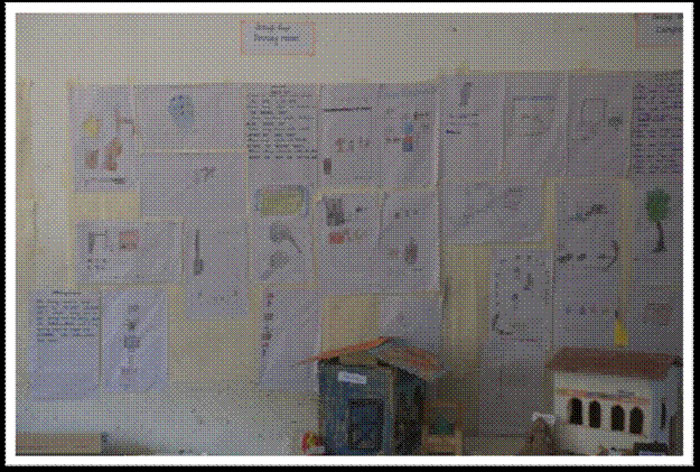
Figure 107. Display by the Primary 2 dining room group.
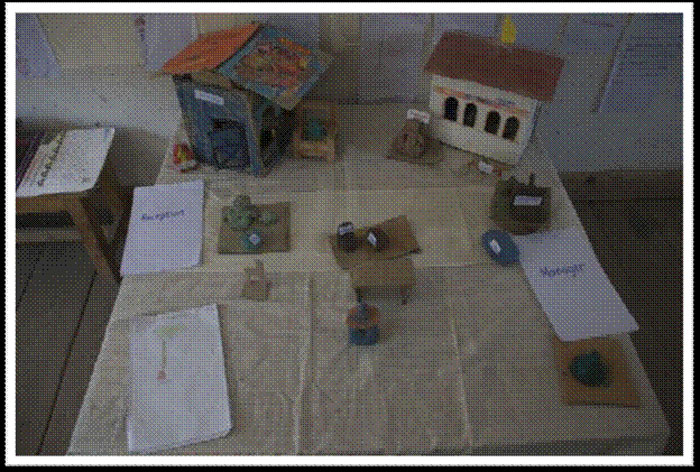
Figure 108. Display showing the dining room, the reception area, and people who work at the Gangtey Hotel.
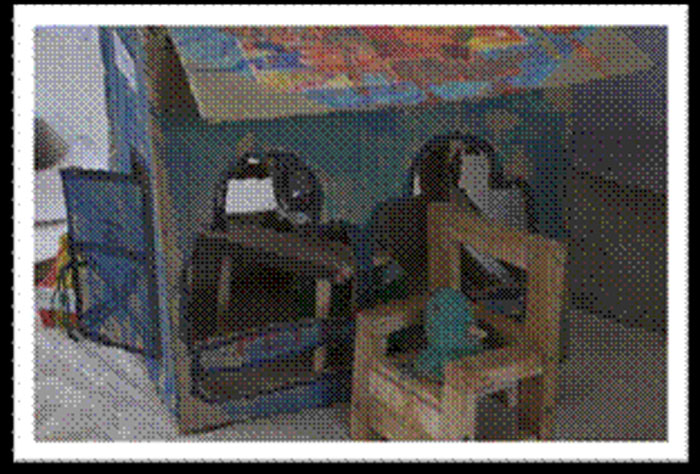
Figure 109. Detailed furnishings created by Primary 2 children.
Conclusion
As this action research project ended, the researchers concluded that, for the Primary 1 and Primary 2 children of Taju Elementary School and their teachers, the Project Approach provided a supportive framework for introducing new ways of teaching and learning that are more child friendly than traditional methods. Working through the three phases of the Project Approach engaged children and teachers in activities and processes that facilitated their transformative development.
The authors observed that during their participation in this action research project, the teachers Deki and Dechen experienced and enacted new ways of thinking, teaching, and learning (Wells, 2000, pp 60-61):
- Constructing collaborative communities within their classrooms and beyond
- Engaging in purposeful processes that involve all aspects of the children’s development
- Incorporating activities that are situated and unique
- Expanding the role of curriculum beyond the typical expectation of preparing for exams
- Producing outcomes that are both aimed for and emergent
- Constructing activities that, by their nature, allow diversity and originality
Constructing Collaborative Communities
Projects allow teachers to select topics that are relevant to the children, their families, and their community. The authors noted that the participating teachers demonstrated their recognition and appreciation of the importance of identifying and utilizing local funds of knowledge. The response of the parents and community to the Project Approach was positive; they saw that it provided many ways for them to support the children’s learning despite the high rate of illiteracy among parents. In turn, the children were able to engage more easily with topics and ways of learning that were familiar and meaningful to their families and community members.
Purposeful Processes Involving All Aspects of Development
From the teachers’ perspective, the processes involved in doing project work led to more than covering the curriculum with the children; they helped to develop in the children the dispositions to learn, share, problem solve, make decisions—knowledge and skills that, while articulated in Bhutan’s curriculum, are rarely seen in practice in the classrooms.
Deki and Dechen indicated that they were particularly pleased that project work supported dispositions for self-motivation and self-regulation. They reported that they had spent less time disciplining children and more time in dialogue with them. They also noted that a wider English vocabulary was naturally introduced in the context of meaningful activities; the children spoke more English than they did in their usual classroom work.
Incorporating Unique and Situated Activities
A project like the Primary 2 class investigation of the Gangtey Hotel could not have been done by children living in Sakten, a nomadic community, because it has no hotels. Nor could a similar study have been done even in Bhutan’s capital, Thimphu, because while it has many hotels, none are converted palaces. Similarly, while children might study any school campus as the Primary 1 class did, each school and each set of children involved will be unique, and the available resources and the activities involved in collecting and representing data will be different in each context.
Expanding the Uses of Curriculum
The authors noted that the teachers felt they could justify spending time on project work because it supported statements and directives from the Ministry of Education, such as the following:
Teachers are encouraged to not only take a more active approach to learning by having the students participate daily in their learning but also to take advantage of the individual skills students bring to the classroom. When students become more actively involved in their learning, they take more responsibility, creating a positive and productive environment in the classroom.
According to the teachers, important aspects of Gross National Happiness such as sustainable and equitable socioeconomic development and the preservation of the environment are addressed through project work. Deki and Dechen also came to see project work as a meaningful and focused way to integrate a wide range of curriculum areas, because many different subjects and topics can be embedded seamlessly in all phases of the investigation.
Producing Outcomes That Are Both Aimed for and Emergent
Project work allowed the integration of many cultural aspects of education that were not explicit in the curriculum but that the teachers felt were important. One example was the history of the Gangtey Hotel, which people at the hotel told to the children on their visit. This dialogue with community members gave the children a sense of where they and their families fit in that community and helped them to form a sense of identity.
The authors and the teachers noted the children’s responses to being photographed throughout the project. Limitations of time and resources were barriers to giving cameras to the children. However, the children became aware of the role of the camera as way of recording their learning; they sometimes requested that the adults take photos of particular pieces of work that they thought best reflected their learning and accomplishments.
Constructing Activities That Allow Diversity and Originality
When a range of opportunities for visual representation were made available, children demonstrated abilities and knowledge that until then had not been apparent. Through discussion with the children about their representations, the teachers obtained insights into the complexity of the children’s thinking. For the first time, they became aware that they had greatly underestimated both the children’s abilities and their potential for expressing what they observed and learned. The children rose to the challenges of working with new media and became increasingly creative as they progressed through the projects.
Concluding Comments
The focus of this paper has been on what occurred in the Taju Primary School setting. However, the researchers also found that involving some lecturers from the College of Education was also invaluable for demonstrating to them how project work might be enacted in a Bhutanese context. The experience of working with teachers and children in school, along with the photographic documentation (visual ethnography), will be used in a new Teaching Methods module in the Bachelor of Education Primary program. These productive links between the school, homes, community, and the College of Education, created through this action research project, will, we hope, continue to grow.
References
Brooks, Margaret. (2006). Using visual ethnography in the primary classroom. Journal of Australian Research in Early Childhood Education, 13(2), 67-80.
Brooks, Margaret. (2009a). Drawing to learn. In Marilyn Narey (Ed.), Making meaning: Constructing multimodal perspectives of language, literacy, and learning through arts-based early childhood education (Vol. 2, pp. 9-30). New York: Springer.
Brooks, Margaret. (2009b). Drawing, visualisation and young children's exploration of “big ideas.” International Journal of Science Education, 31(3), 319-341.
Cohen, Louis; Manion, Lawrence; & Morrison, Keith. (2007). Research methods in education. London: Routledge.
Davydov, V. V., Slobodchikov, V. I., & Tsukerman, G. A. (2003). The elementary school student as an agent of learning activity. Journal of Russian and East European Psychology, 41(5), 63-76.
Department of Education, Ministry of Health and Education. (n.d.). Education sector strategy: Realising vision 2020, policy and strategy. Thimpu, Bhutan: Author.
Edwards, Susan. (2010, April). Teaching through assessment: The merging of technology and assessment in teacher education learning contexts. Paper presented at ACEC2010: Digital Diversity Conference. Melbourne, Australia.
Egan, Kieran. (2010). Learning in depth: A simple innovation that can transform schooling. Chicago: University of Chicago Press.
Fleer, Marilyn; Edwards, Suzy; Hammer, Marie; Kennedy, Anne; Ridgeway, Avis; Robbins, Jill; & Surman, Lynne. (2006). Early childhood learning communities: Sociocultural research in practice. Camberwell, Victoria: Pearson Education Australia.
Goldman-Segall, Ricki. (1998). Points of viewing children's thinking: A digital ethnographer's journey. Mahwah, NJ: Erlbaum.
Gonzalez, Norma, Moll, Luis C.; & Amanti, Cathy (Eds.). (2005). Funds of knowledge: Theorizing practice in households, communities, and classrooms. Mahwah, NJ: Erlbaum.
Gross National Happiness Commission, Royal Government of Bhutan. (2009). Tenth five year plan (2008-2013). Thimpu, Bhutan: Author.
Grundy, Shirley. (1995). Action research as professional development. Perth, Australia: Arts Accord Affiliation of Arts Educators.
Katz, Lilian G., & Chard, Sylvia C. (2000). Engaging children's minds: The project approach (2nd ed.). Stamford, CT: Ablex.
Moll, Luis C.; Amanti, Cathy; Neff, Deborah; & Gonzalez, Norma. (1992). Funds of knowledge for teaching: Using a qualitative approach to connect homes and classrooms. Theory into Practice, 31(2), 132-141.
Pink, Sarah. (2002). Doing visual ethnography. London: Sage.
Wells, Gordon. (2000). Dialogic inquiry in education: Building on the legacy of Vygotsky. In Carol D. Lee & Peter Smagorinsky (Eds.), Vygotskian perspectives on literacy research: Constructing meaning through collaborative inquiry (pp. 51-85). New York: Cambridge University Press.
Wink, Joan, & Putney, LeAnn. (2002). A vision of Vygotsky. Boston: Allyn & Bacon.
Author Information
Dr. Margaret Brooks is a senior lecturer at the University of New England. Her research focuses on young children's drawing processes and the relationships between drawing and meaning making from sociocultural perspectives. She uses arts-based and visual ethnographic methods to examine the drawing processes of both children and adults. Her most recent work involves collaborations with artists, young children, and art museums around environmental issues in Bali, Indonesia. For the past three years, she has also regularly consulted with the Royal University of Bhutan and the Ministry of Education on the development of early childhood education in Bhutan.
Margaret Brooks
Senior Lecturer, Early Childhood Education
School of Education
University of New England
Armidale NSW 2351 Australia
Telephone: 02-6773 2654
Fax: 02-6773 2445
Email: mbrooks3@une.edu.au
Tshering Wangmo was a lecturer cum programme leader for the Bachelor of Primary Education in the Paro College of Education under the Royal University of Bhutan. She has worked for many years as a teacher educator and contributed a lot to the education of primary teachers in Bhutan. Tshering currently holds an Australian Leadership Awards Scholarship for her Ph.D. study in Examining Funds of Knowledge as Children Transition from Home to School in Bhutan.
Tshering Wangmo
School of Education
University of New England
Armidale, NSW, 2350
Australia
Telephone: 02-6773 2906
Email: teewang84@yahoo.com

